High Desert Inspired Ornaments
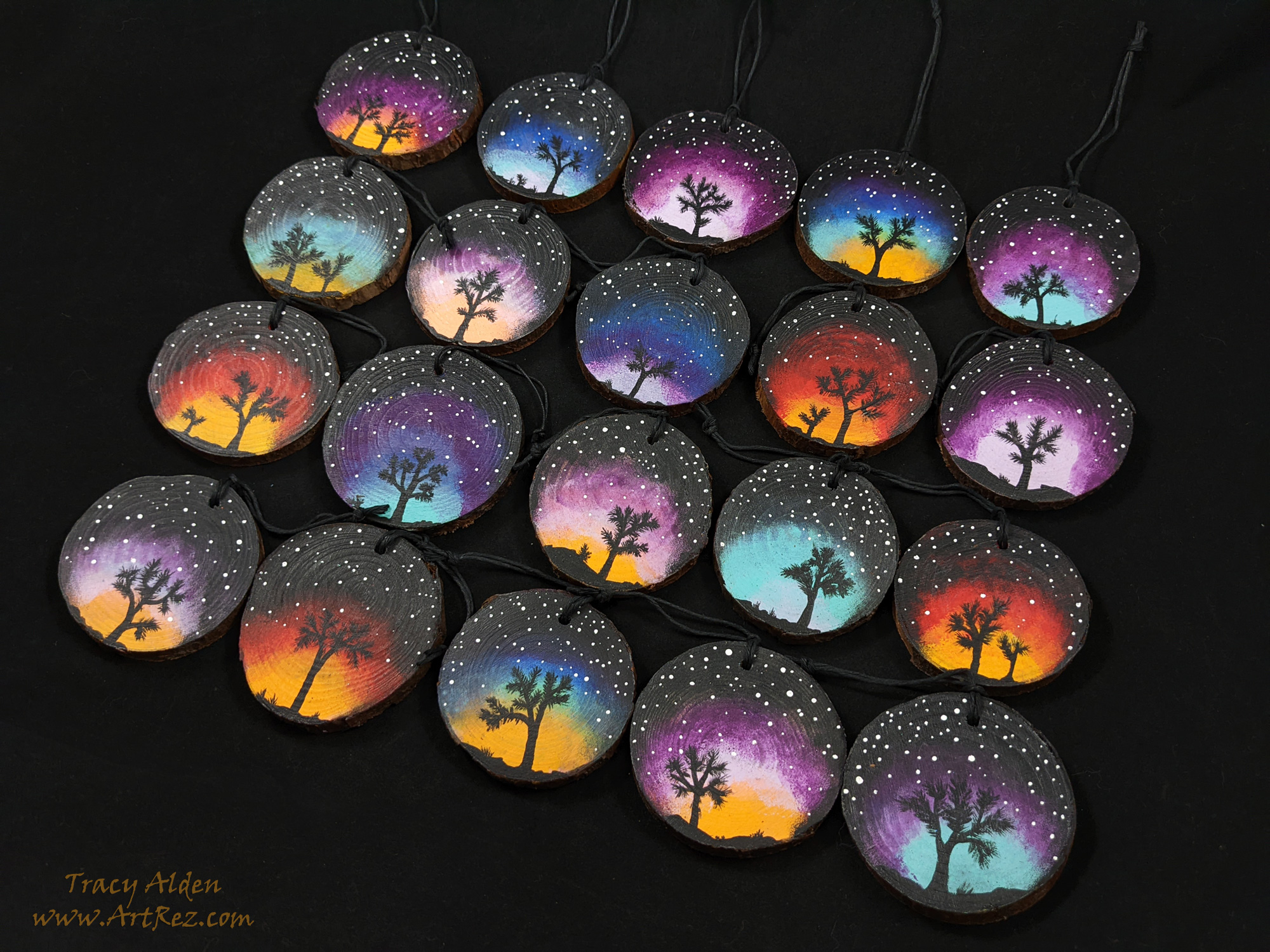
As a child growing up in the high desert I found many inspirations for my artwork in the surrounding area. From sagebrush, seasonal flowers, quartz glistening out of the earth, to animals roaming in the distance. My recent painted ornament collection comes from those childhood inspirations.
One of the most unusual and iconic images of the high desert is the Joshua tree (Yucca brevifolia), a member of the Agave family. An important part of the Mojave Desert ecosystem, Joshua trees are home to all types of wildlife. Birds, mammals, insects, and lizards all live with, in and around Joshua trees. A favorite subject for many southwestern artists to paint, carve and sculpt in their preferred media.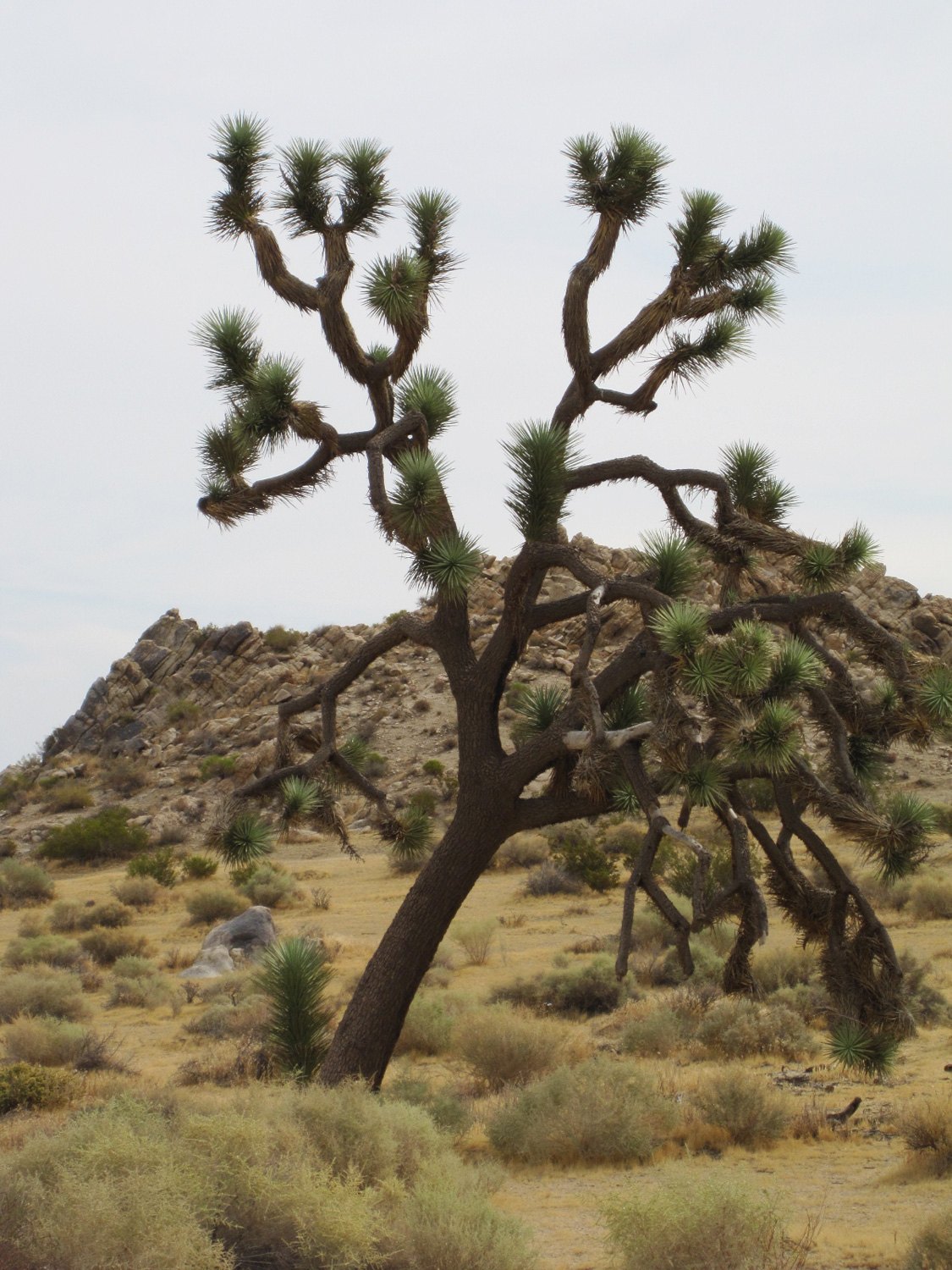
Sometimes seen as unruly, these slow growing trees create a striking silhouette in the high desert. For many living in the high desert, snow covered Joshua trees are seen as a traditional holiday image. Following that tradition I wanted to create holiday ornaments highlighting the Joshua tree.

Another familiar sight to the high desert is the relentlessly gorgeous sunsets and sunrises. In hues of red, pink, yellow, purple, blue and soft grey, the sky is an ever changing canvas. These unfiltered displays of colors are the natural background for Joshua trees in Winter months.

Using photos of Joshua trees, high desert sunsets and sunrises that I took as reference, I painted blank pine wood slices. Layer by layer early morning and twilight high desert scenes came to life.
By painting in a folk art style, I found the process of making each ornament relaxing, bringing back happy holiday memories. Once each pine wood ornament was painted, they were signed and varnished. Many of the ornaments now have happy new homes for the holidays.
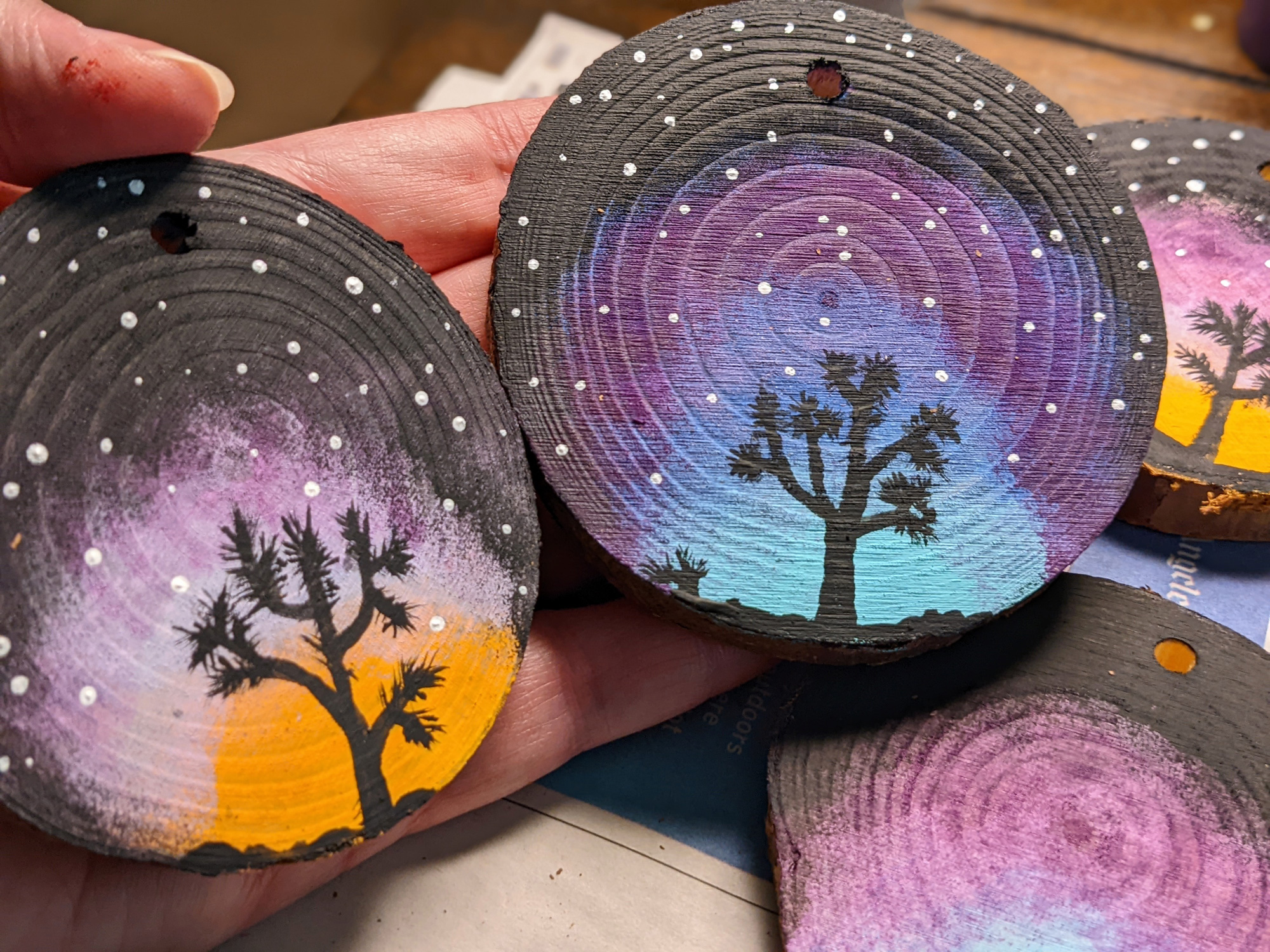
Until Next Time, Stay Crafty, Stay Safe!- Acrylic, Association For Creative Industries, Chalk Paint, Contests, Convention, Diamond Art, FaveCrafts, History Inspired, Home Decor, Mixed Media, Mod Podge, Throwback Thursday
#TBT Traveling a Forgotten Path, with Diamond Art
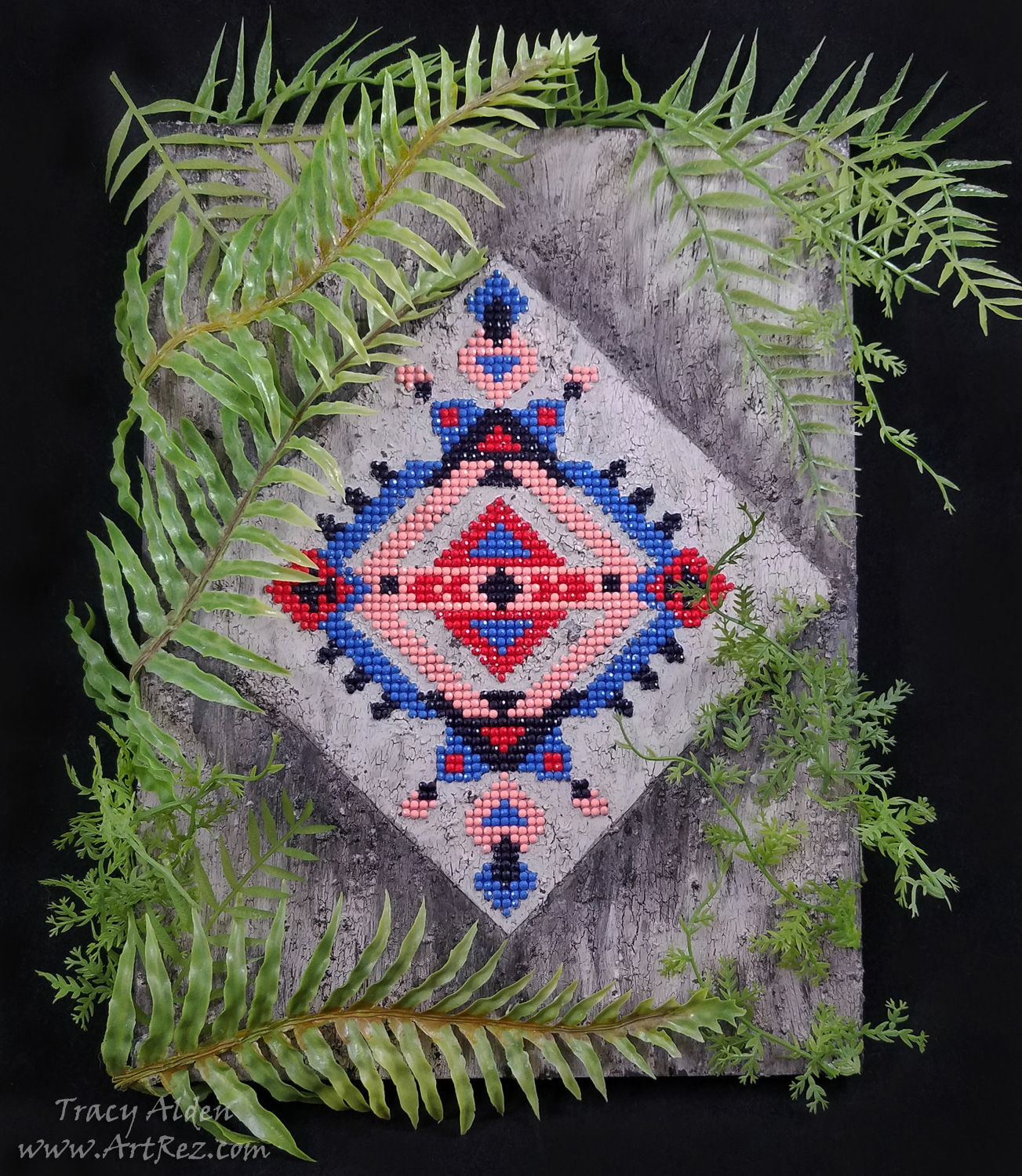
Hello! Continuing my Throwback Thursday posts, this time only going back to January, when I once again traveled to the Creativation Trade show, in Phoenix, Arizona. Held by Association For Creative Industries or AFCI, during the show I was honored to once again be invited to the 7th annual Prime Networking Event. This event gives bloggers, designers, authors and brands in the craft industry a chance to come together to network, make new partnerships, and learn about new product information. The event was fun, informative, and free product samples were provided by this year’s sponsors. After the event attendees were encouraged to try out and create art for the Favecrafts Best Blogger Craft Event. This year I won runner up in the Best Blogger Contest 2019 for my project!
For my entry I decided to use products from these sponsors: Diamond Art by Leisure Arts, Tribe Design, Mod Podge Ultra Matte Spray, FolkArt Crackle Medium and Home Decor™ Chalk Paint along with supplies from my personal collection of art supplies.
Supplies:
Diamond Art by Leisure Arts Diamond Painting Kit – Tribe Design
Mod Podge ® Ultra Matte Spray
FolkArt ® Mediums – Crackle Medium
FolkArt ® Home Decor™ Chalk Paint in Java, Parisian Grey, White Adirondack and Black
Liquid Fusion ® Clear Urethane Glue
9 inch x 12 inch Cradled Wood Board
Assortment of artificial tropical plants
1 Flat Paint Brush
1 Round Paint Brush
Scissors
Ruler
Pencil
Cotton swabs
Isopropyl alcohol
Used and dried coffee groundsSince it took a few hours to finish the Diamond Art kit by Leisure Arts, I had time to consider the pattern. In my mind it needed something more than to just be framed. It reminded me of patterns of old, and FolkArt Chalk Paint would help me with that. To have it look like a wall fragment I would need it to be on a board, Mod Podge Spray would help apply the canvas. For water damaged cracks, I would need a Crackle Medium.
Maybe it could be a forgotten image, now found once again? Slowly a story formed in my mind…..
After traveling many miles, you start seeing the remnants of a once mighty city, now taken over by nature. Slowly walking through the dense forest a fragment of a patterned wall slowly appears. What ancient artist created this image and who was it intended for?
I opened up my Leisure Arts Diamond Painting Kit and made sure I had all of the required parts. The printed canvas needed to be flattened a bit before I started so making sure to leave the sticky film cover on the canvas, I placed a book on top of my canvas for a few hours before starting.

Following the instructions included with the Diamond Art I applied all of the flat backed diamonds to the canvas. It took me only a few hours to complete.
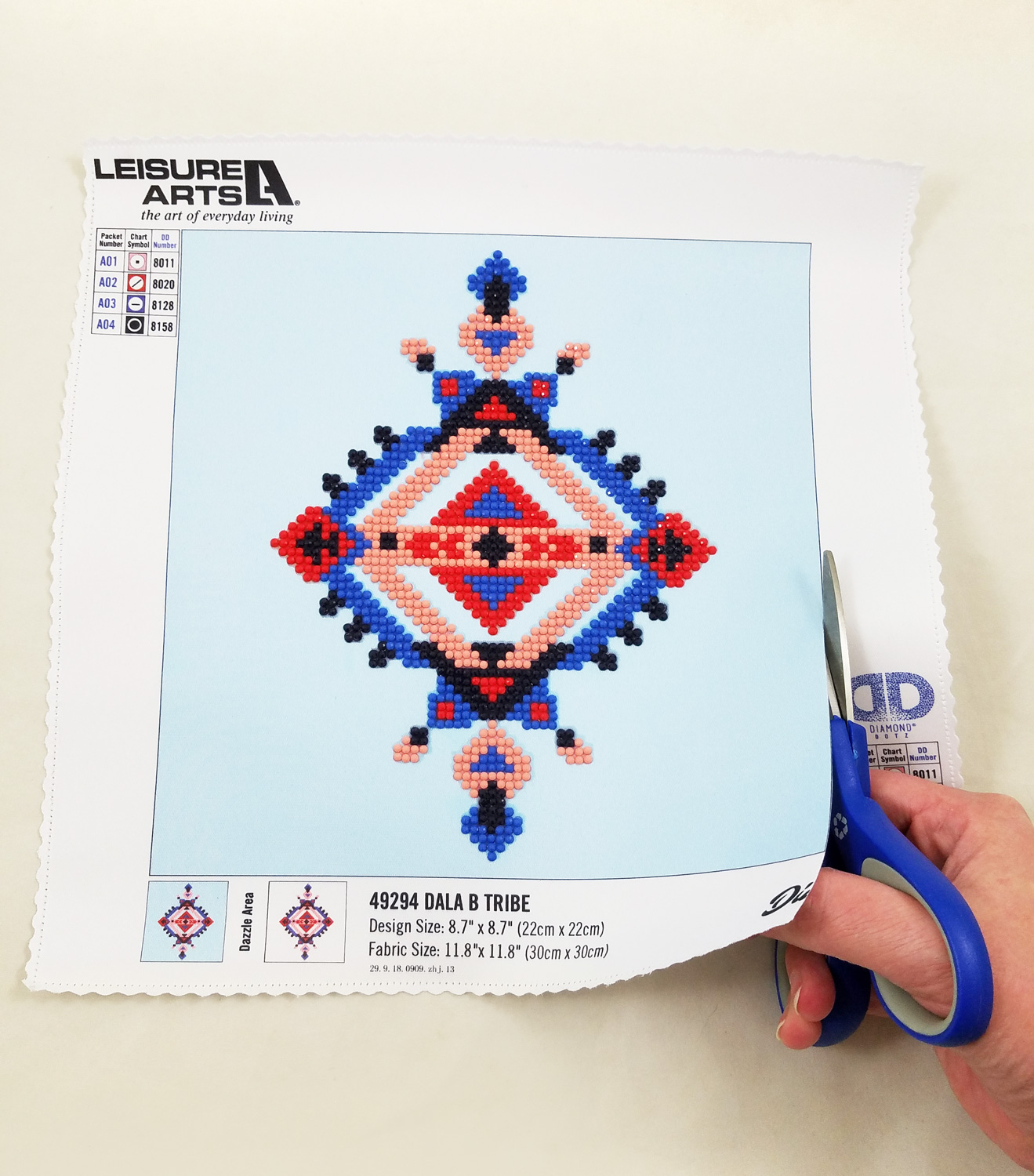
Next I trimmed the Diamond Art canvas to the very edge of the blue background with a pair of sharp scissors.
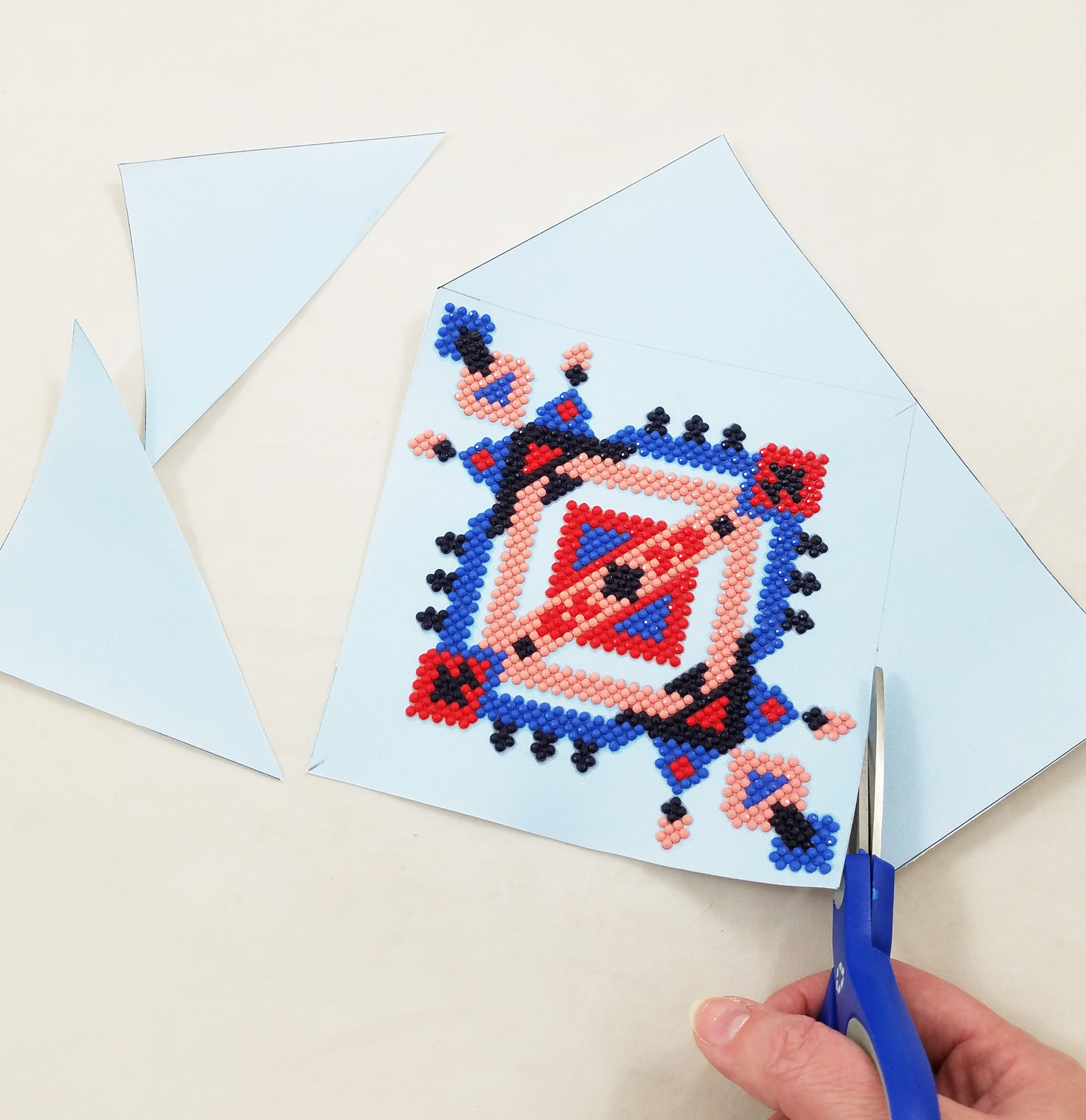
I carefully used a pencil and ruler to mark as close as possible to the Tribe Design pattern, creating a slightly elongated diamond outline. I then trimmed the canvas further with the scissors, using my pencil lines as my guide.
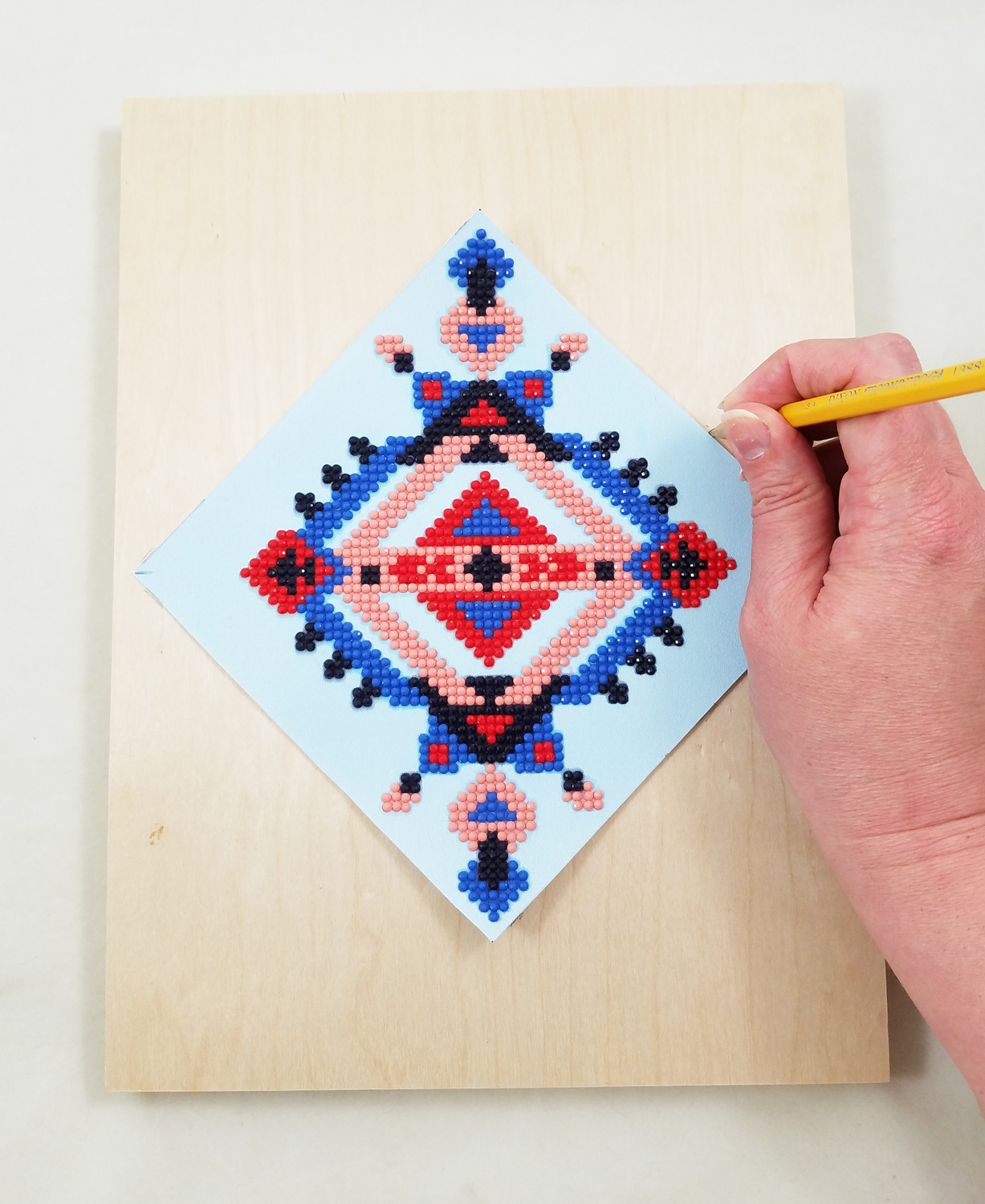
Now that the Diamond Art canvas was cut to size, it fit neatly on the wood board I wanted to attach it to. Once again, I used my pencil to mark out the exact placement of my canvas on the wood board.

Making sure my wood board was clean of dust or particles I sprayed it with Mod Podge Ultra Matte in the pencil outline of the diamond.
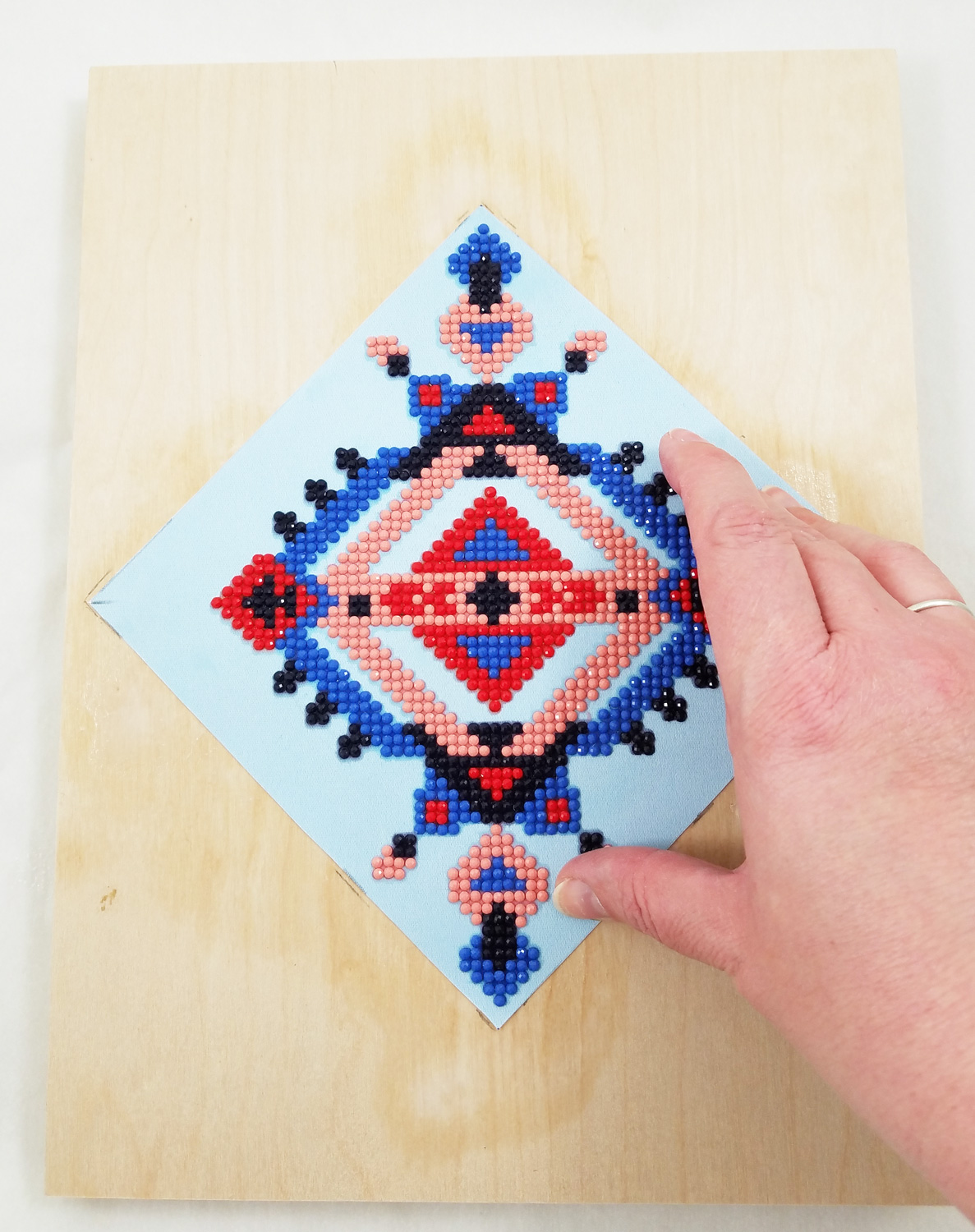
Quickly and carefully I applied the diamond canvas to the coated wood board. I applied firm pressure to the canvas. The spray version of Mod Podge Matte makes it much easier to apply fabric without a worry of oversaturation or bubbles forming. I let the Mod Podge fully dry.
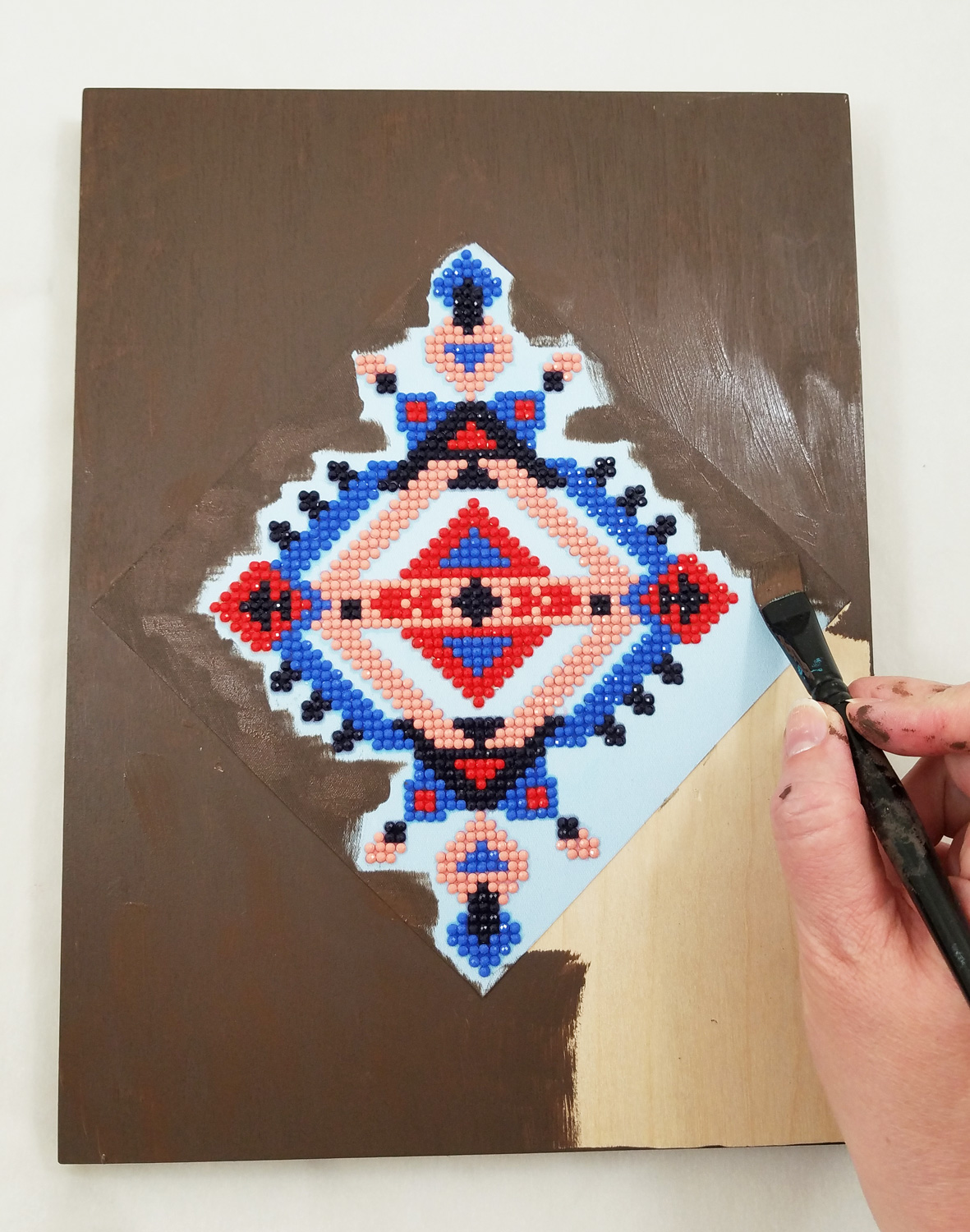
Making sure to cover the sides and front of the wood board I applied on FolkArt Home Deco Chalk Paint in Java. Using the flat paint brush to apply paint to the open sections of the wood board and the round brush for the detailed sections around the diamonds. The Tribe Design canvas had a tendency to soak up more paint, so I applied a bit more paint to make sure there was even coverage.
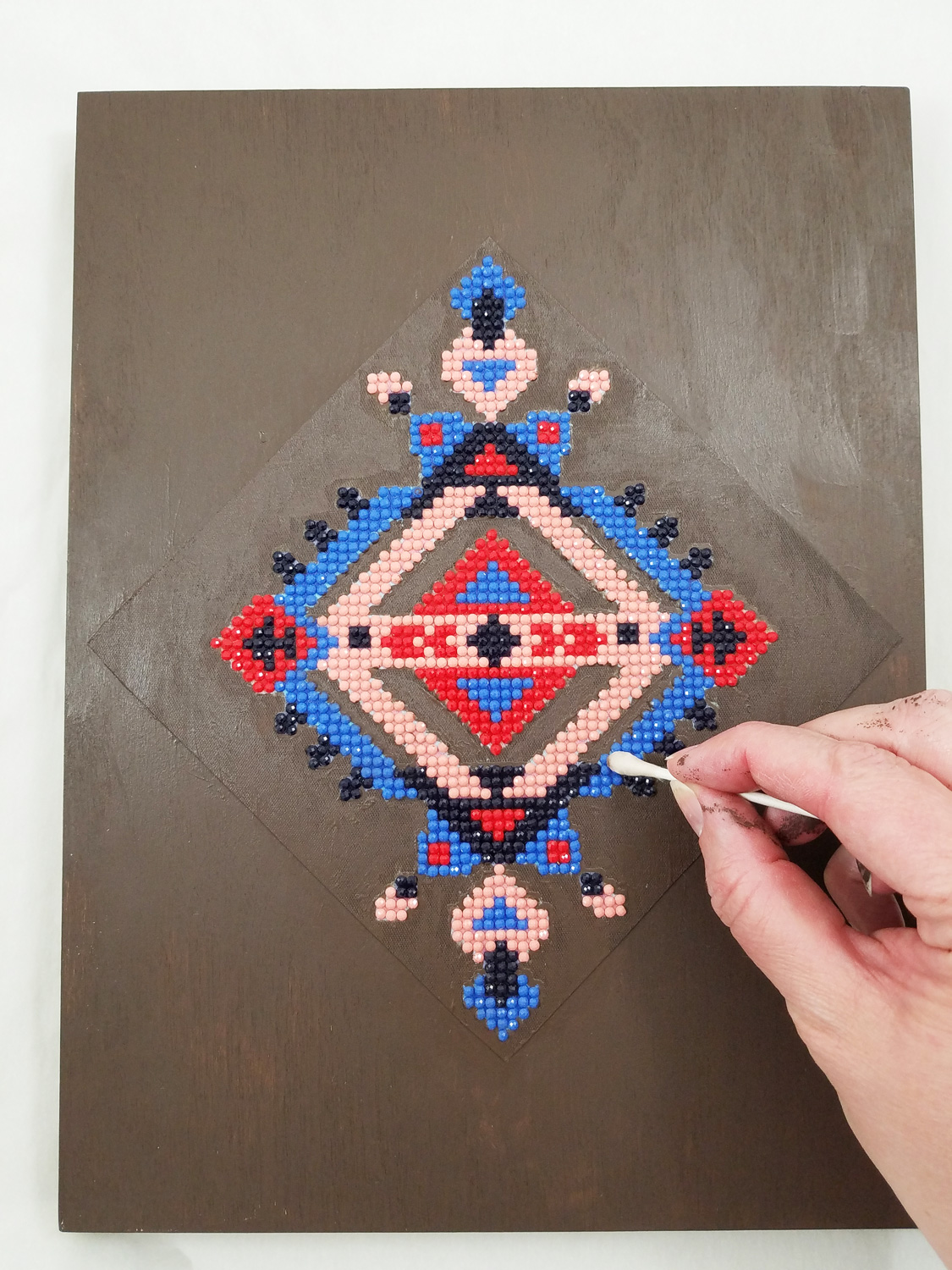
Before the paint fully cured I used cotton swabs dipped in isopropyl alcohol to remove any paint that accidently covered the diamonds. I then let the paint fully cure before the next step.

On the now dry paint I applied FolkArt Crackle Medium, careful to not over brush and to only apply the medium in one direction. This would ensure a better crackle formation later on. I let this layer fully dry.
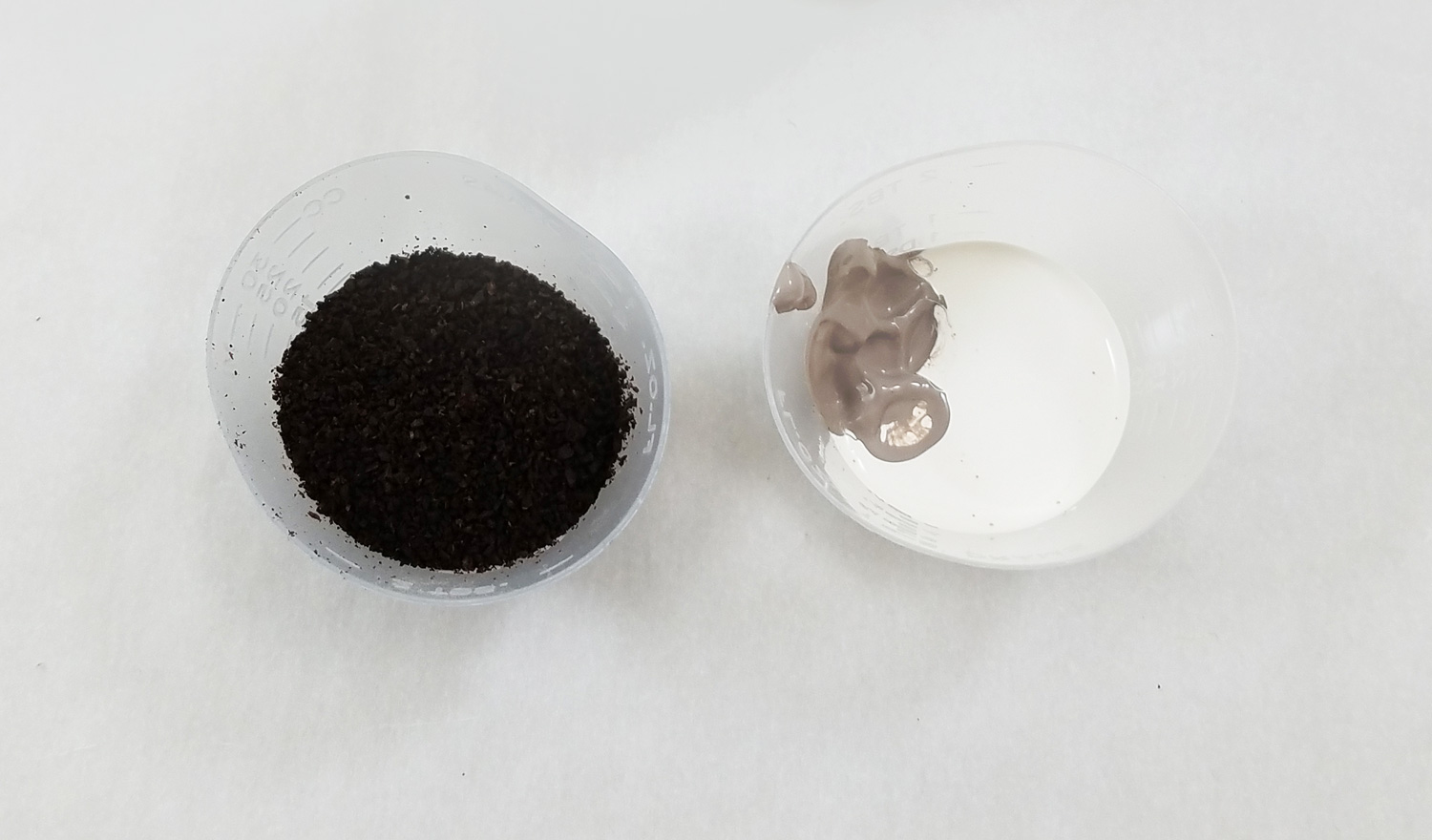
To create a highly textured topcoat I mixed a tablespoon of used and dried coffee grounds in a small cup, with 4 parts FolkArt Home Decor Chalk Paint in White Adirondack, with 1 part Parisian Grey.
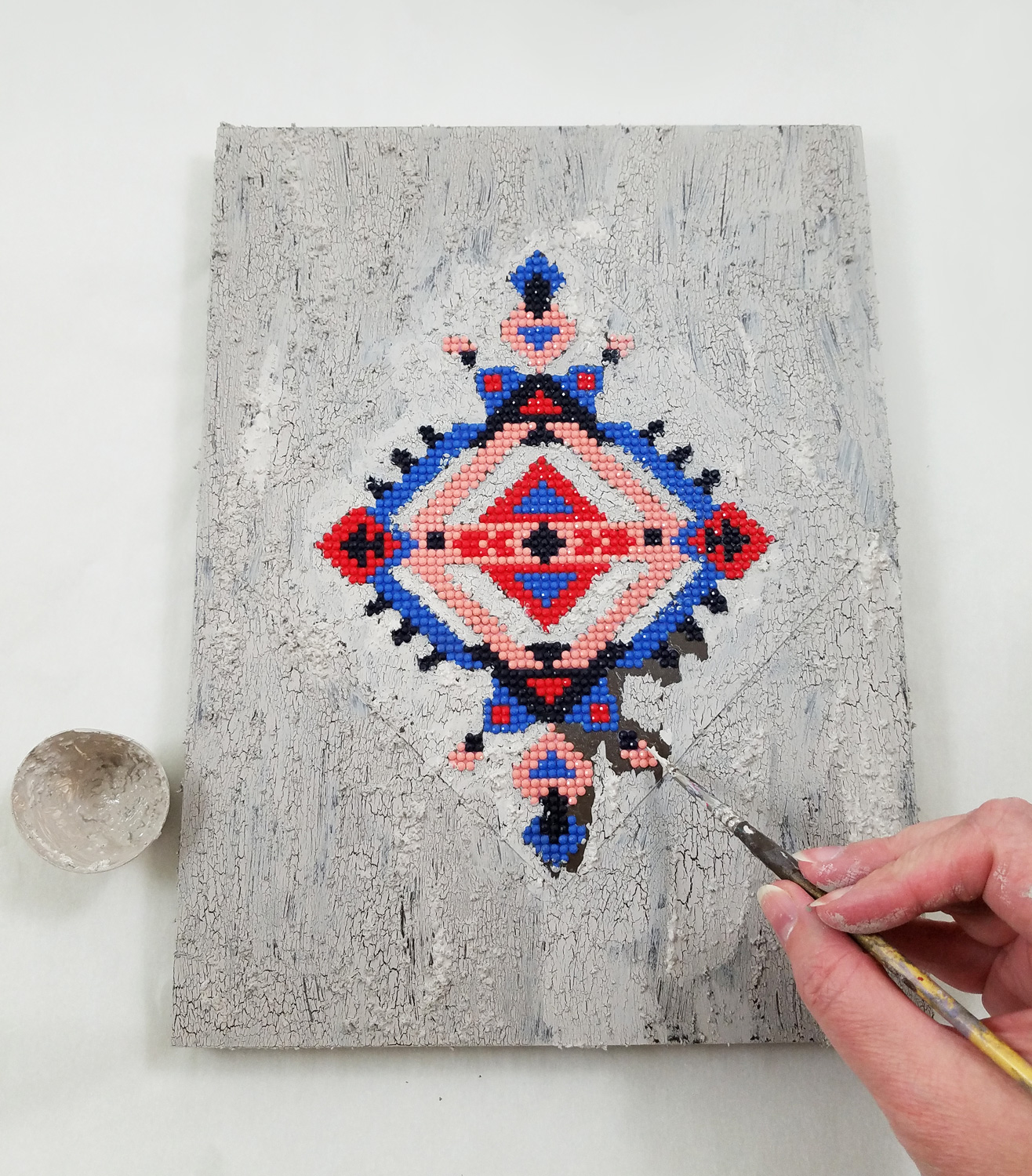
I quickly applied my textured topcoat to the crackle layer, making sure once again to not over paint, and for the most part, go only one direction with the brush strokes. Any time the paint built up too much on the brush I cleaned the paint brush with a paper towel and then reapplied fresh paint mixture to the brush.
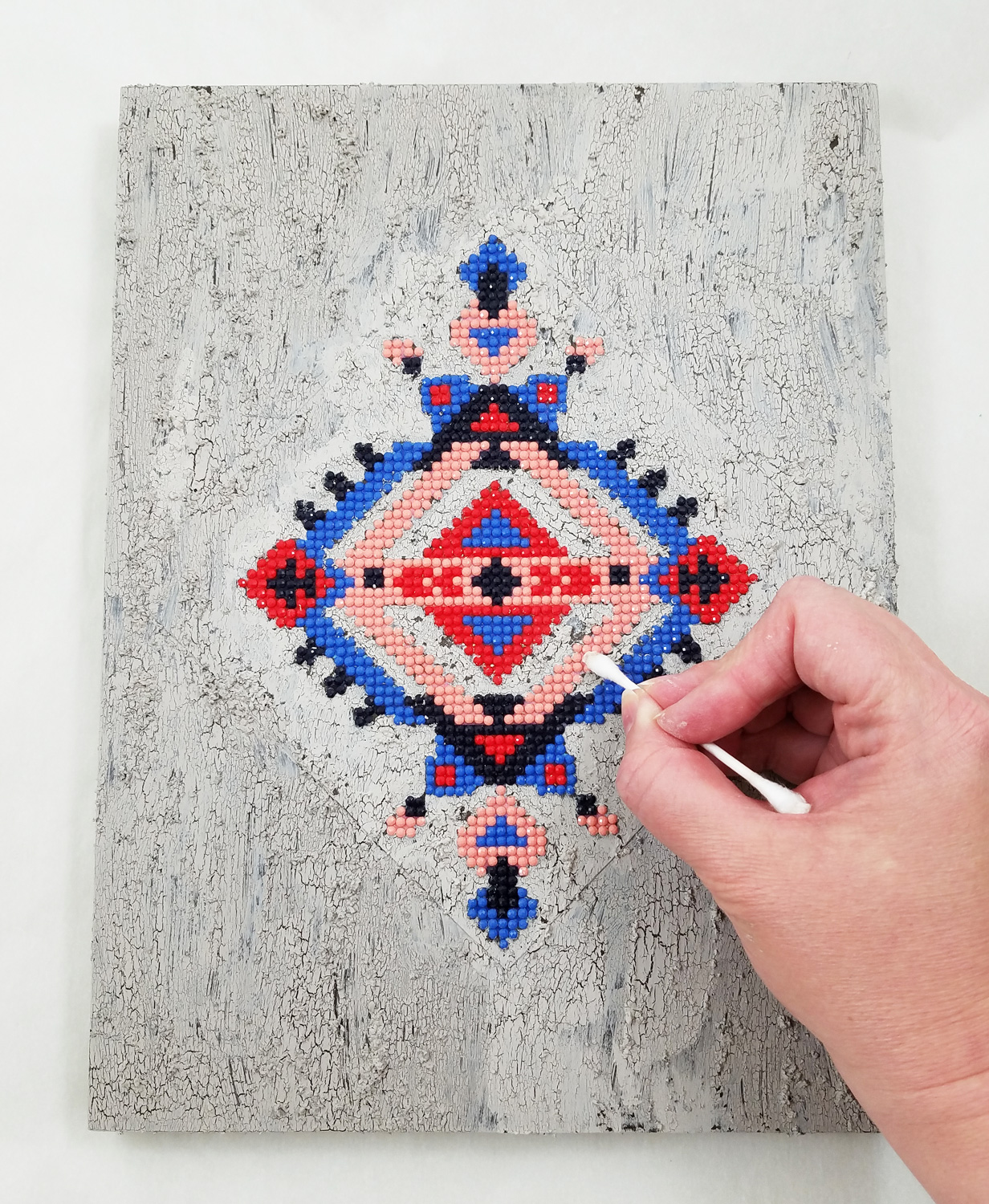
Once again before the paint fully cured I used cotton swabs dipped in isopropyl alcohol to remove any paint that accidentally covered the diamonds. I then let the paint fully cure before the next step.
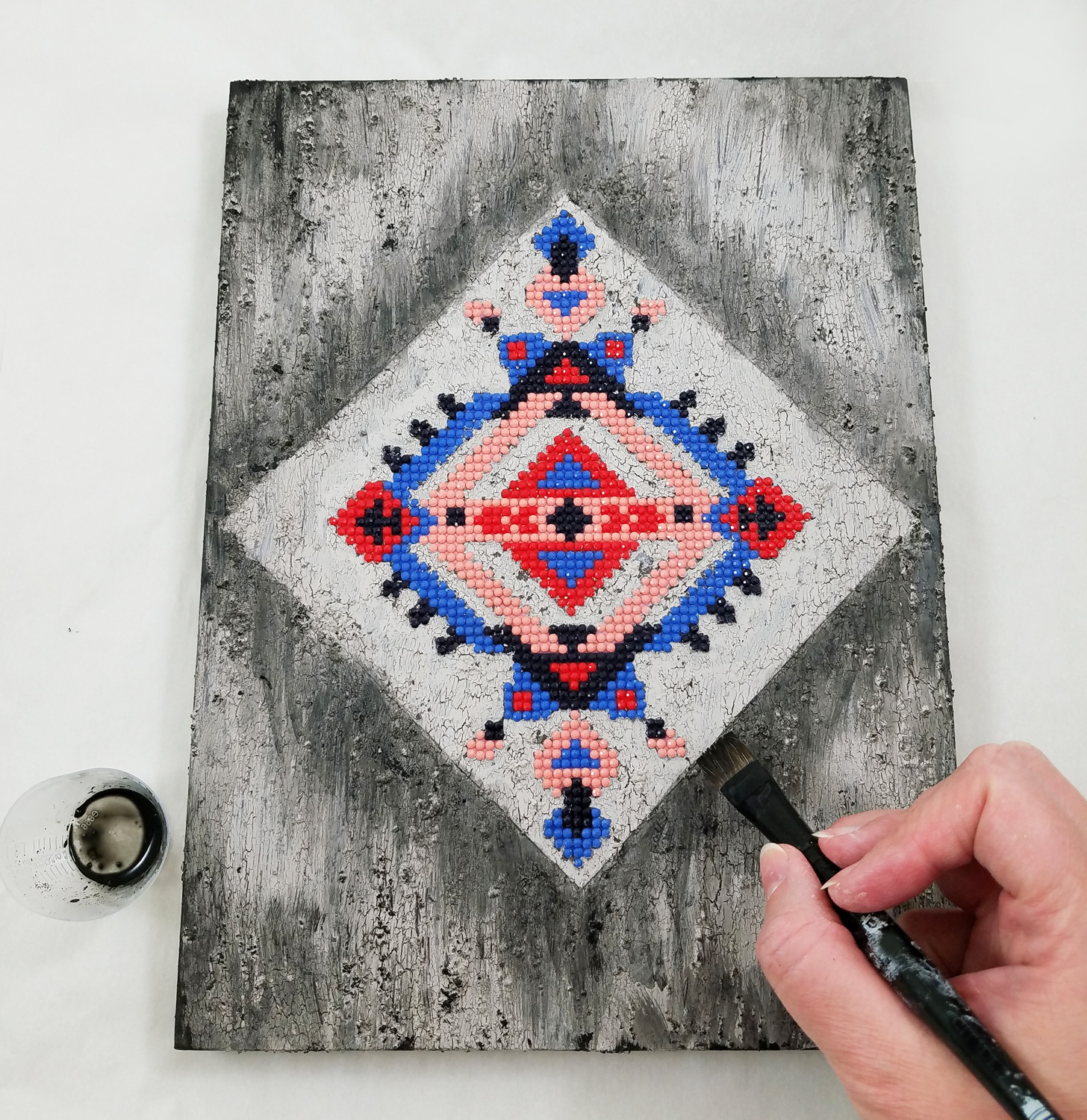
In a small cup I heavily diluted some Black FolkArt Home Decor Chalk Paint with some water and applied it to the cracks, textured elements and raised portions of the wood board, careful to avoid the flat backed diamond pattern. I left the paint to fully dry.
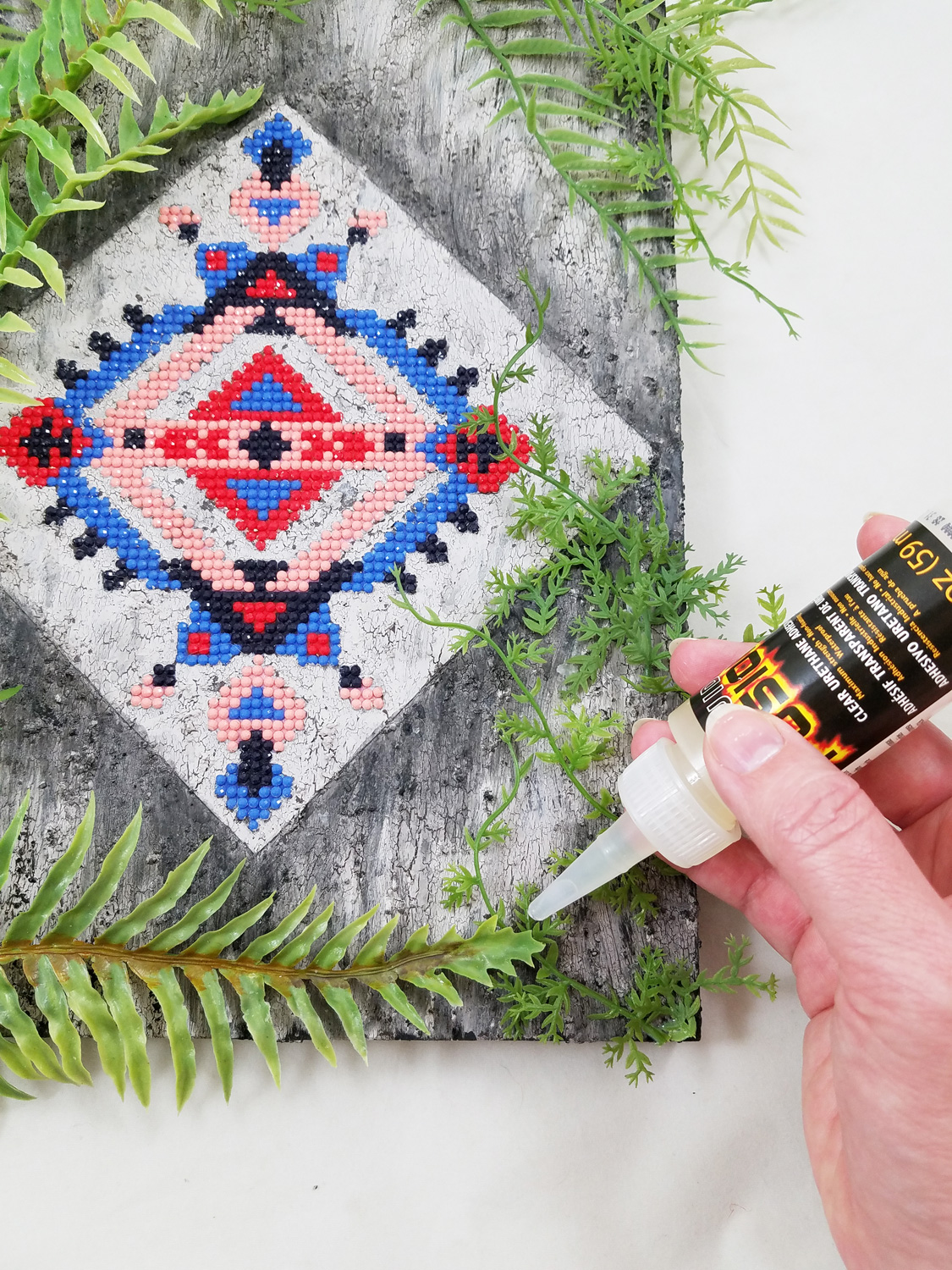
I cut and placed the artificial tropical plants on the board, finding the placement I liked best, gluing the plants in place with Liquid Fusion Clear Urethane Glue. Once the glue was fully cured my pieces was ready to be displayed.
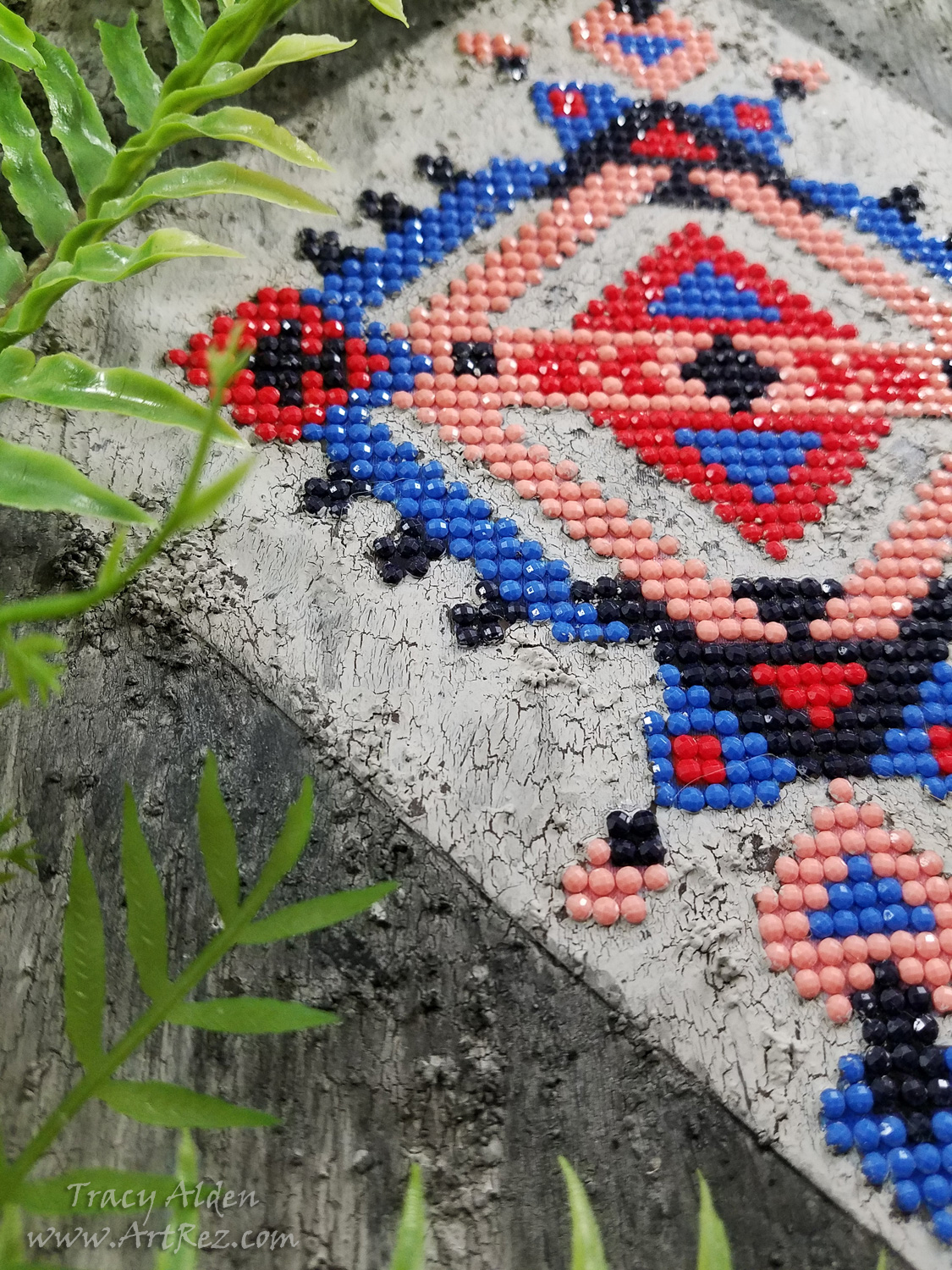
Until next time, safe travels!
*This is an affiliate post, which means I received an assortment of products as a compensation for the creation of art. To read my full disclosure, click here. Upcycled Fabric Cedar Sachets

Since I was a child I was raised to save fabric. My childhood was full of stories from my grandmother, who lived through the Great Depression and my mother, who lived through WWII, on how they learned to be frugal and resourceful, saving things to turn into something new. Outgrow a shirt? Pants have too many holes? Curtains sun damaged? Fabric left over from making a dress? Save the fabric! The years have sped by, and in this modern world the ease and access to any number of arts and crafts supplies is astounding. However there is a want and even a need to reduce, reuse, or recycle long forgotten craft supplies.
One of my favorite upcycled crafts I was raised on making was fabric sachets. Both pretty and practical, these little bits of fabric, crafted into any number of shapes, stuffed with cedar, would decorate the house, protect our clothing from insects and remind us of loved ones present and past.Supplies:
Fabric scraps
Small pieces of lace and/or trim
Small lengths of ribbon or thin strips of fabric such as linen or muslin
Thread
Sewing needle
Buttons
Fabric Scissors
Cedar shavings (many pet shops and hardware stores have large bags available)
Cedar Essential oil
Mixing bowl
Sewing Machine *if not hand stitching
Ruler
Pencil
Paper
Craft scissors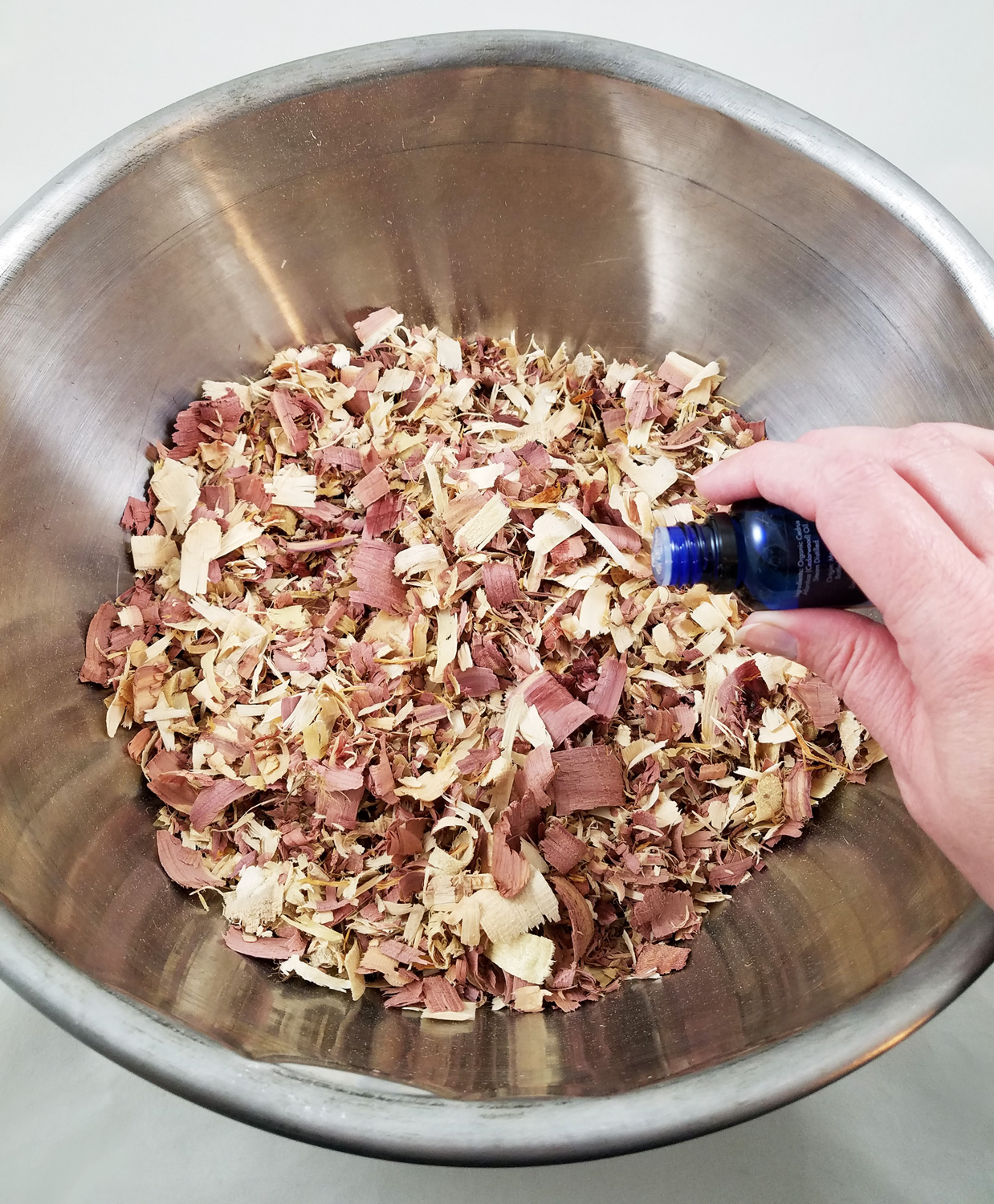
Pour the cedar shavings into the mixing bowl and remove any large chunks of wood or bark from the mix. Sprinkle lightly the cedar essential oil and stir the shavings. Repeat this about 4 times to make sure the shavings have an extra boost of cedar scent. Let the shavings sit and soak up the oil, which can take 5 to 10 hours.
In this pile I have fabric scraps, remnants, old bed linen, swatches of clothing, table cloths and more. The only requirement for any fabric pieces to use in this project is that is to be lightweight and ideally cotton, hemp, linen, muslin or other plant fiber based materials. These will allow the scent of the cedar to release easier over time.
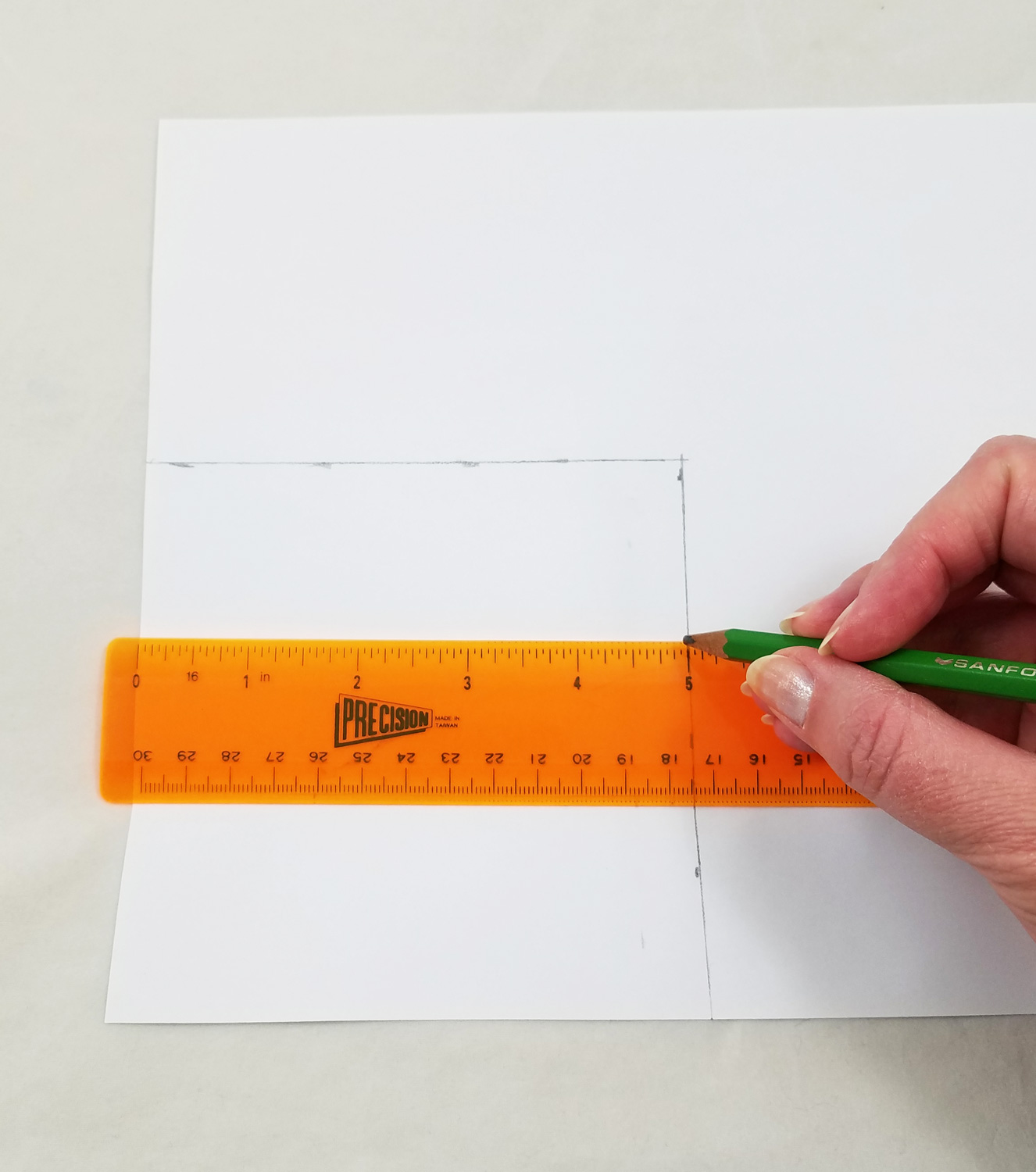
Using a ruler and pencil draw a 5 inch by 5 inch square. This is the starting size for the heart pattern.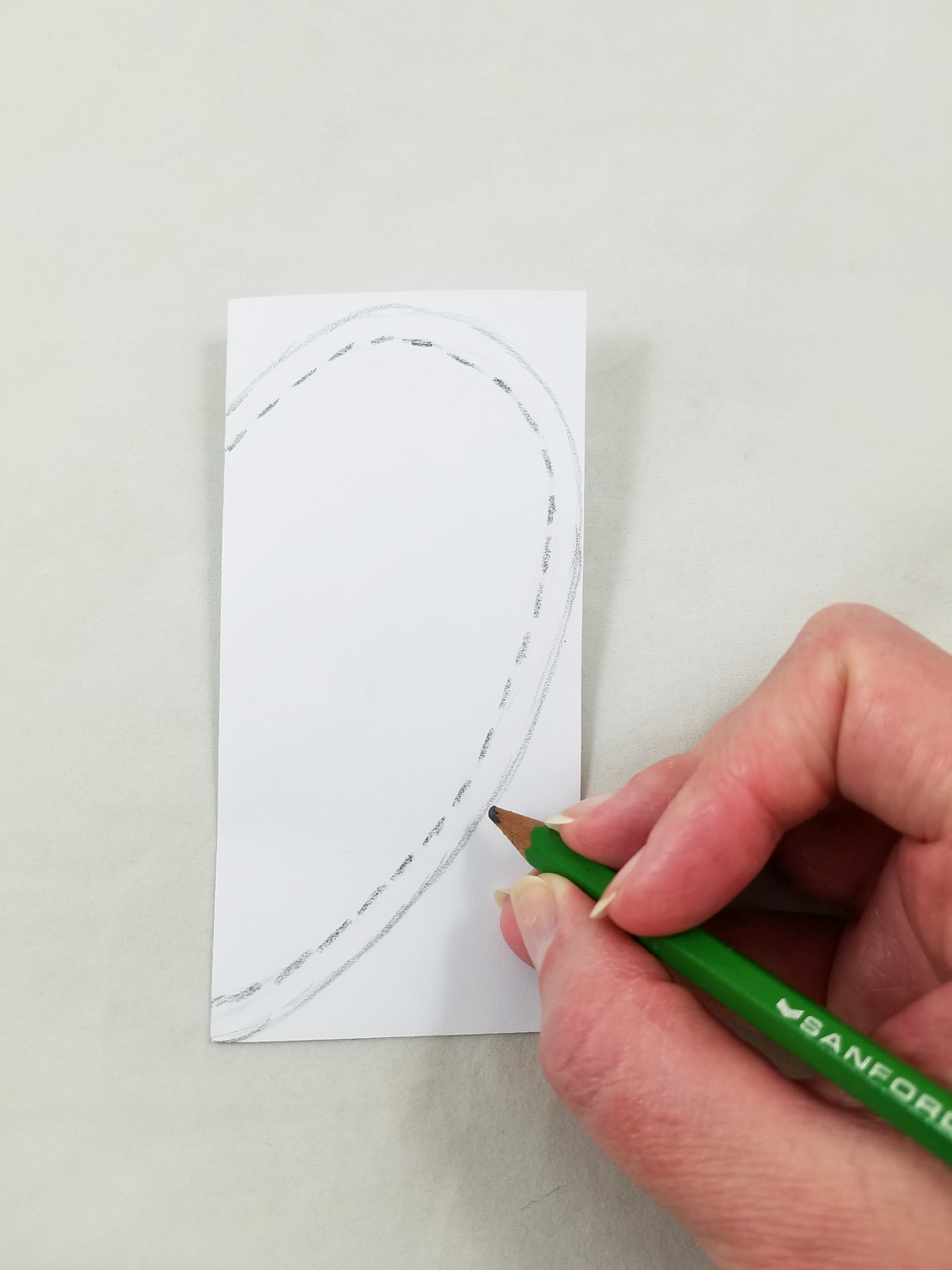
Cut out the 5inch square and fold in half. Staying just within the lines of the paper, draw half a heart. Then within that line draw a second dotted line, ¼” width. This will be the guide for a ¼” seam.
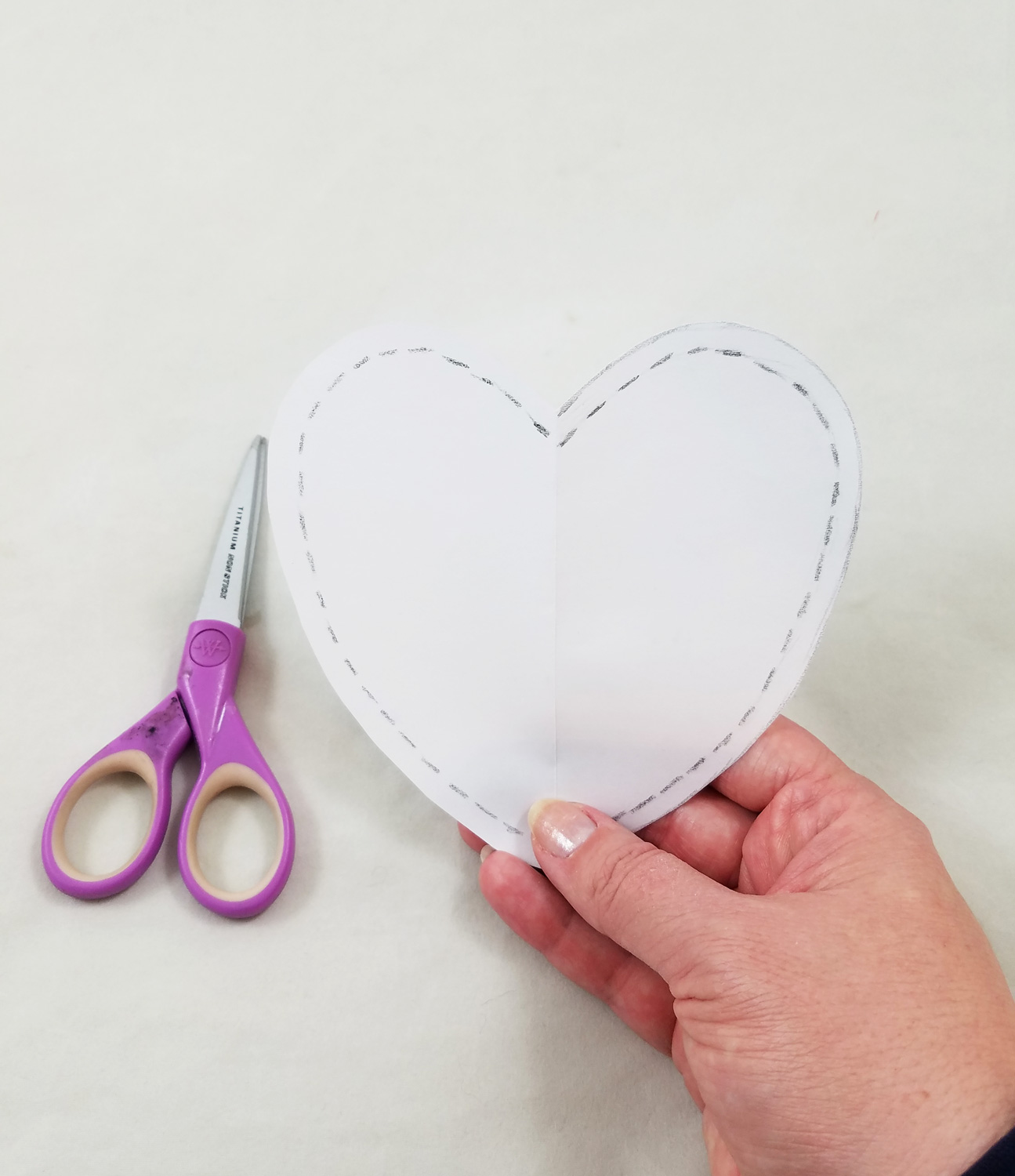
Cut out the paper heart and draw in the ¼” seam allowance dotted line on the second side.
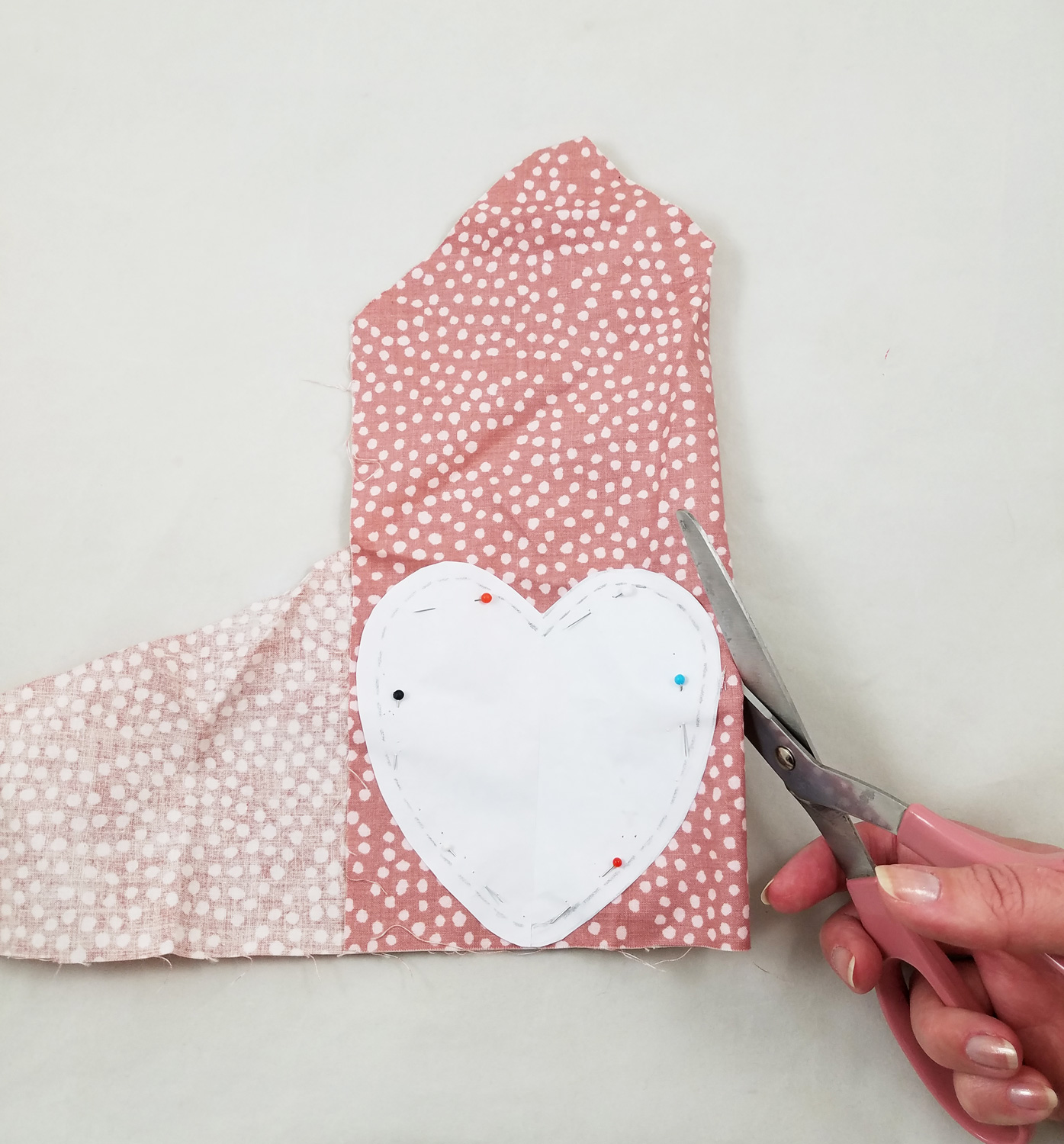
Use the pattern to cut out 2 fabric hearts for each sachet. If possible fold fabric and pin the pattern onto the fabric to cut two fabric hearts at a time if the remnants are large enough.
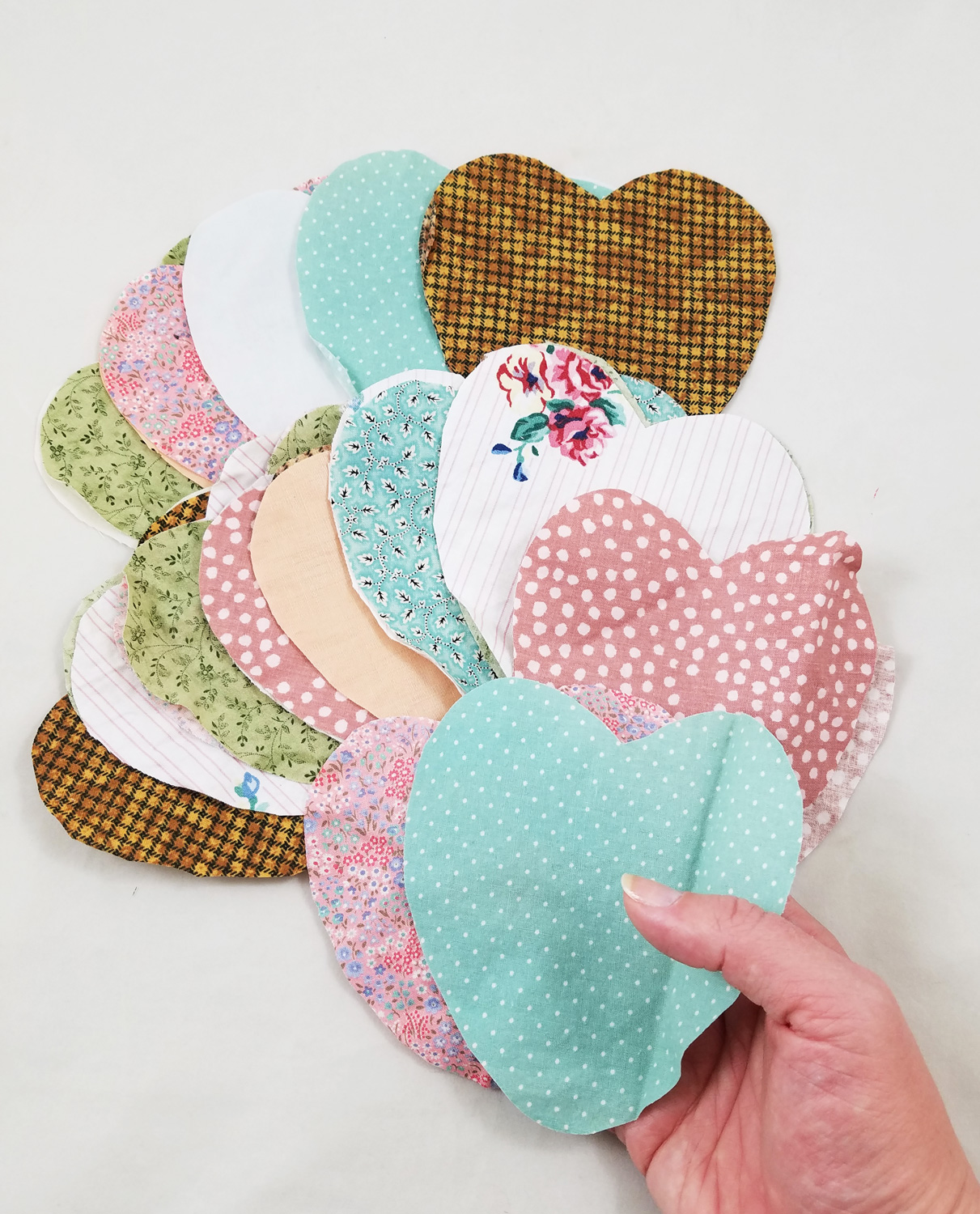
Do not worry if the fabric pieces are only wide enough to cut one heart out, as you can always cut more of a contrasting or complementary fabric.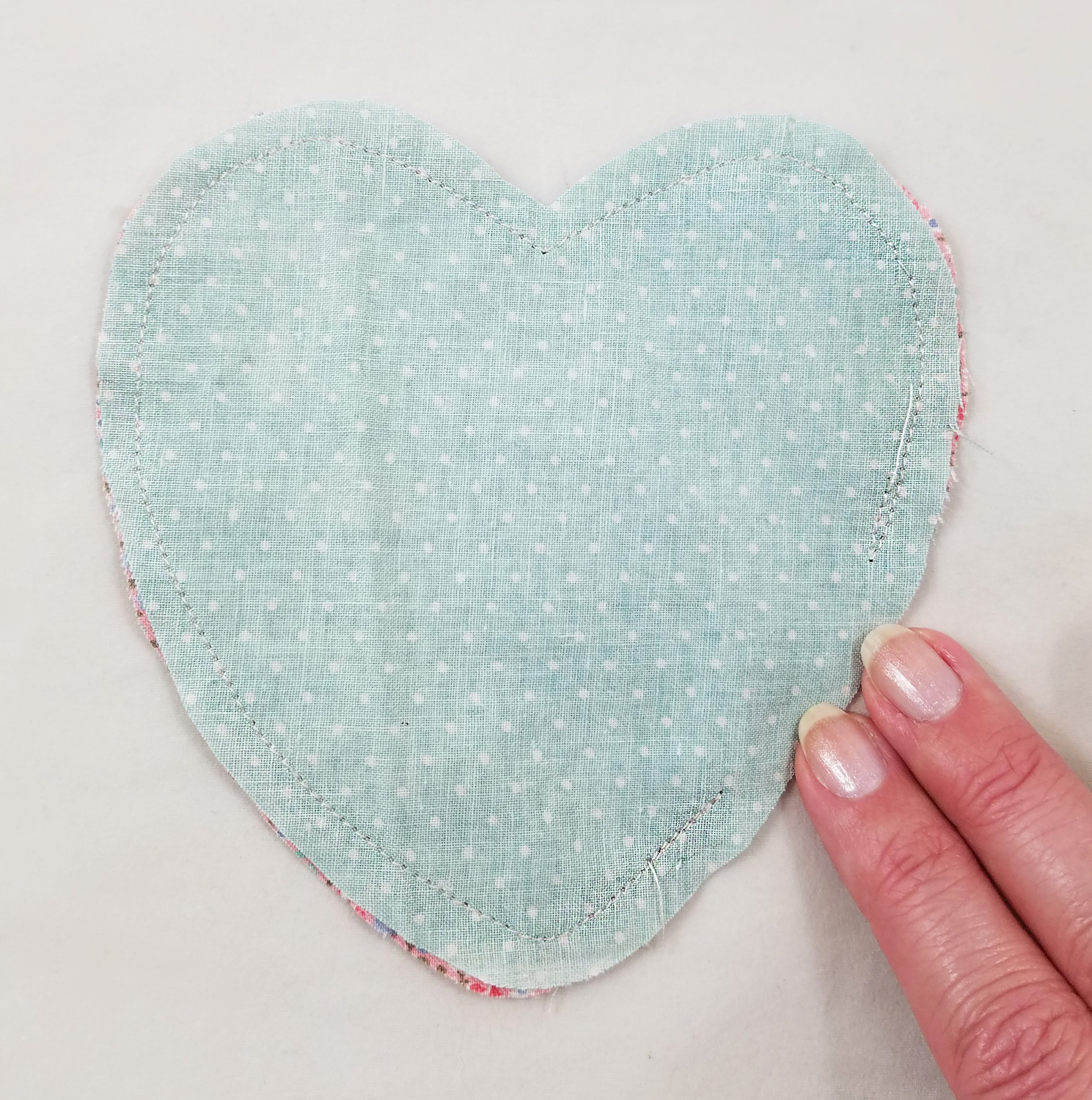
Place the right sides of the fabric hearts together and stitch around the heart with a ¼” seam. Make sure to do a reverse stitch when you start to sew and at the end, as it will strengthen the stitch and prevent it from unraveling when turning rightside out and stuffing the fabric heart. Make sure to leave a portion unstitched, making an opening to turn the fabric heart rightside out.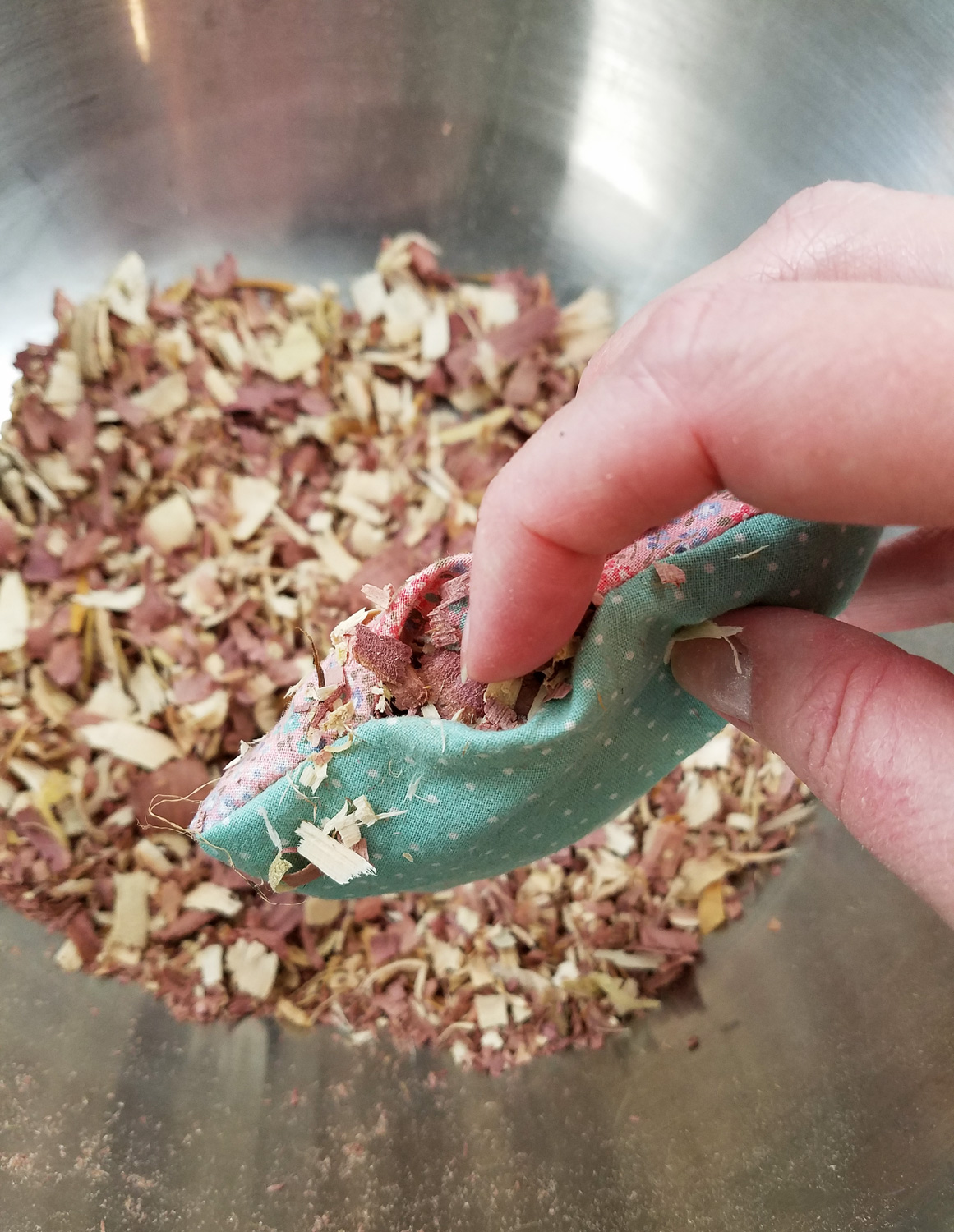
Snip any corners of fabric that might pull or tuck when turned rightside out, such as the dip in the heart or the point of the heart. Turn rightside out and use the eraser end of a pencil to push the heart into shape. Stuff each heart with cedar shavings.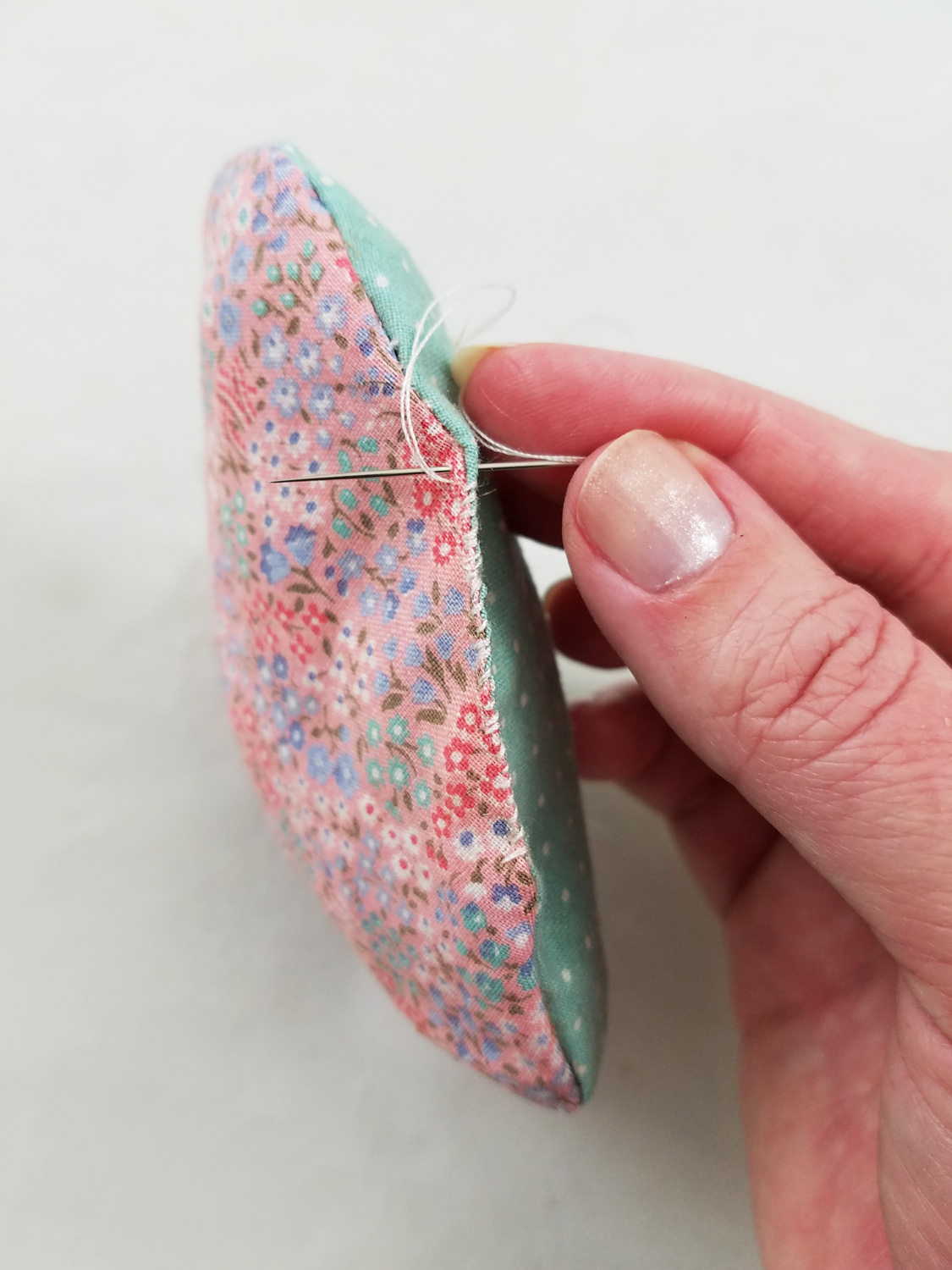
I used an Overcast Stitch to sew up the open part of the heart, as any lace or trim later will cover up the stitches. If you do not want to add lace or trim later, use a Slip Stitch to sew shut the heart.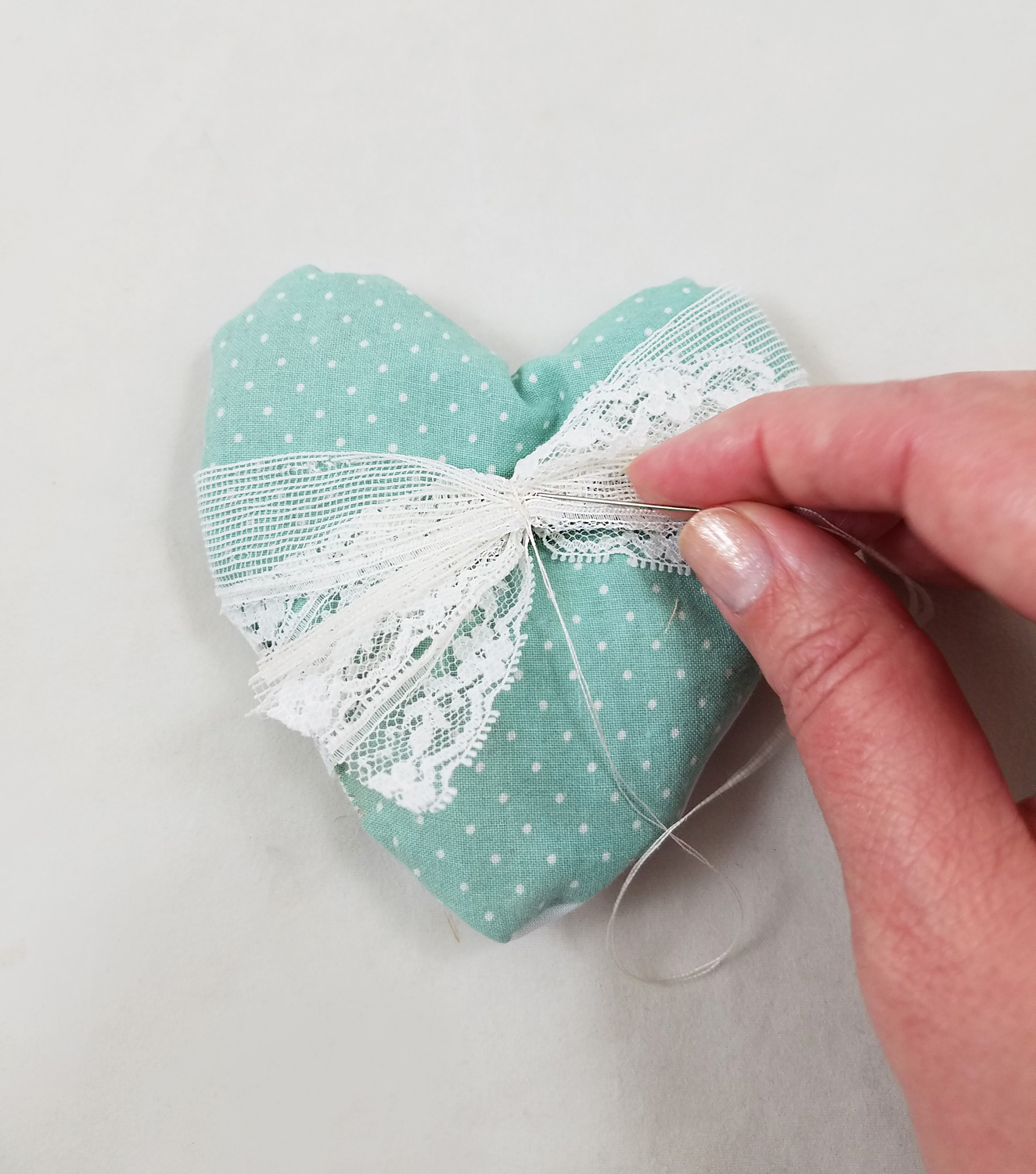
Using a small piece of lace or fabric create a sash that goes around both sides of the heart, making sure to cover the stitch that closed the heart. Gather and stitch together the sash, in the front of the heart. If you do not want a gathered front sash you can always stitch closed the sash on the back of the fabric heart.

Loop a piece of ribbon and stitch the ribbon and a button through the sash and the fabric heart to create a secure hanger for the sachet. Hang your newly created sachet on doorknobs, hangers, coat racks or in boxes or dressers

Different lace and trim placements make each sachet a unique piece. Try making sachets in different shapes, sizes and fabrics. Not a fan of cedar? Switch out the cedar for dried rose petals, rosemary or lavender!Happy Holidays and until next time, safe travels!
Crafty Adventures with Resin and Orchids
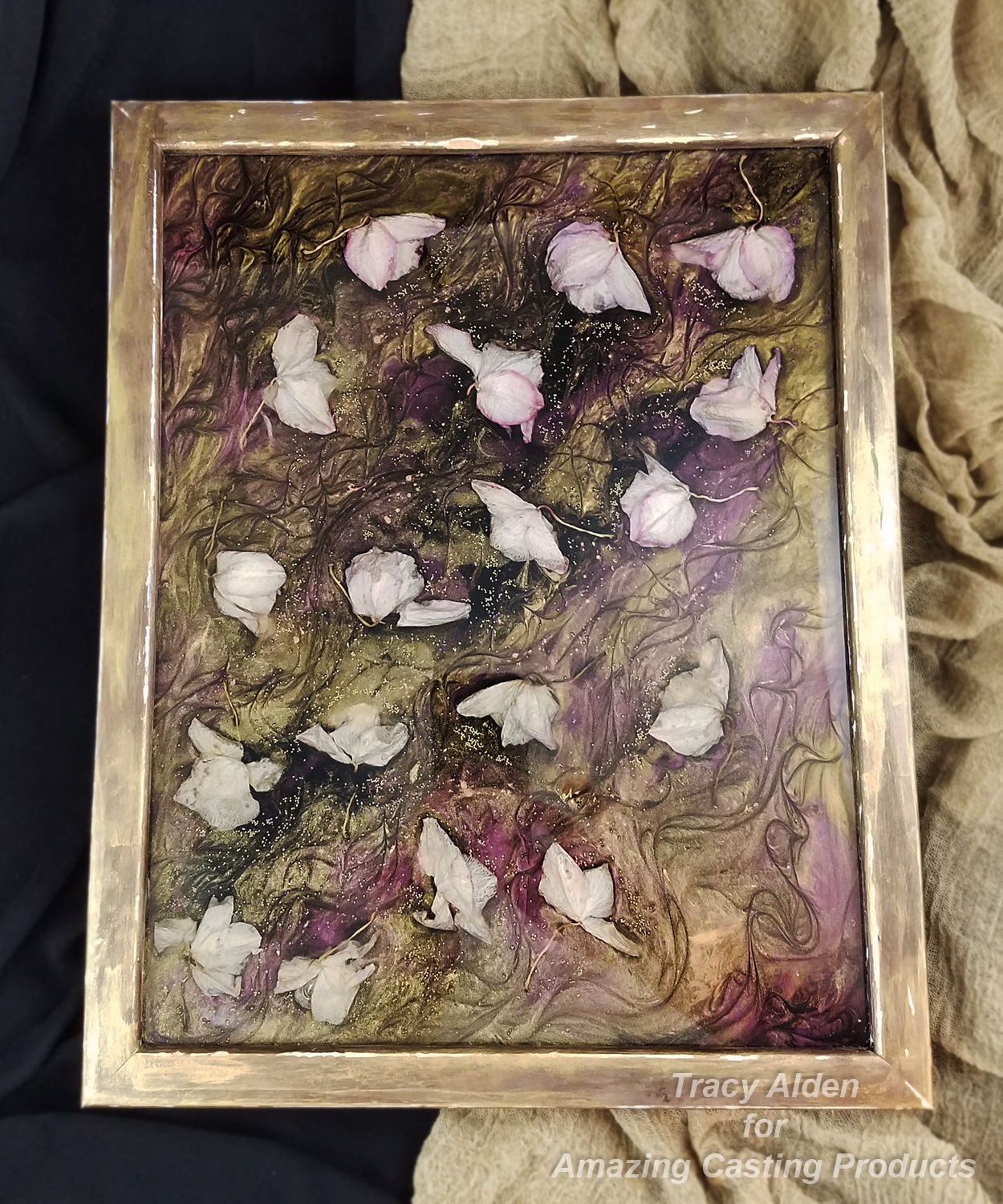
Many of my art projects are tests of both art products and my ability to create. I can collect supplies, start working on something, even get a basic idea of what I would like to do, and end up making something completely different. Being able to adapt and still make a complete project that I can be happy with is my ideal goal, and thankfully this one ended up that way.
Starting with a small collection of orchid blooms that I had dried, I wanted to try to preserve in resin. Dried orchid blooms are very delicate, easily crumbling if mishandled. I decided a frame was the best choice to display the dried orchids and be able to hold the resin in place.
Supplies:
Amazing Clear Cast Resin
Black Alumilite Dye
Alumidust powders Light Pink, Interference Red, Yellow Gold and Brown
Liquitex Gloss Varnish
Dried Flowers
Toothpicks
Stir Sticks
Paint Brush
Acrylic Paint
Picture Frame
Micro Hole-less Glass Beads in Gold and Purple
Measuring Cups
Parchment Paper (Found in the Baking section of most stores) to protect work surfaces
Glue
Baby Wipes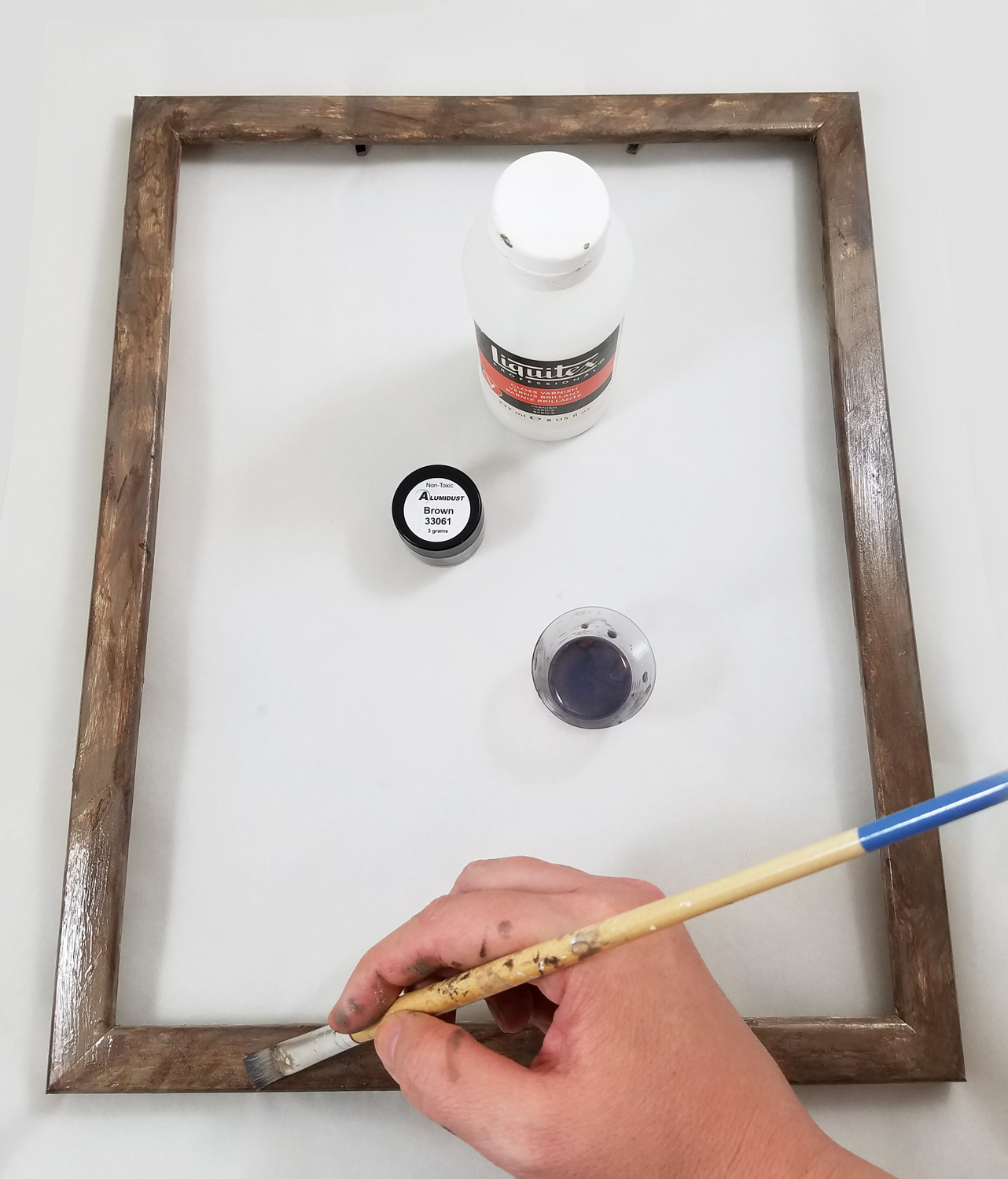
I started with removing the glass and back panel of an old frame. I scrubbed the frame clean and painted the back and front of the frame with 2 coats of paint. I mixed some Brown Alumidust powder with Liquitex Gloss Varnish, as a protective varnish layer over the paint. I let the varnish dry overnight.

I cleaned the glass panel and put it back into the frame. I glued the glass in place to make sure it wouldn’t shift while I worked on it and so resin wouldn’t leak around the edges later. I was careful to have a solid line of glue all the way around the frame and let it dry completely.

I mixed up some Amazing Clear Cast Resin, making sure to slowly stir to reduce air bubbles and let it sit for 5 minutes. I poured the resin into the frame and carefully placed the dried orchid blooms into the uncured resin. I found that with the first layer of Amazing Clear Cast Resin the orchid blooms had a tendency to shift in the resin. So the first layer of resin had to be a thin pour and I let that cure to a tacky set.
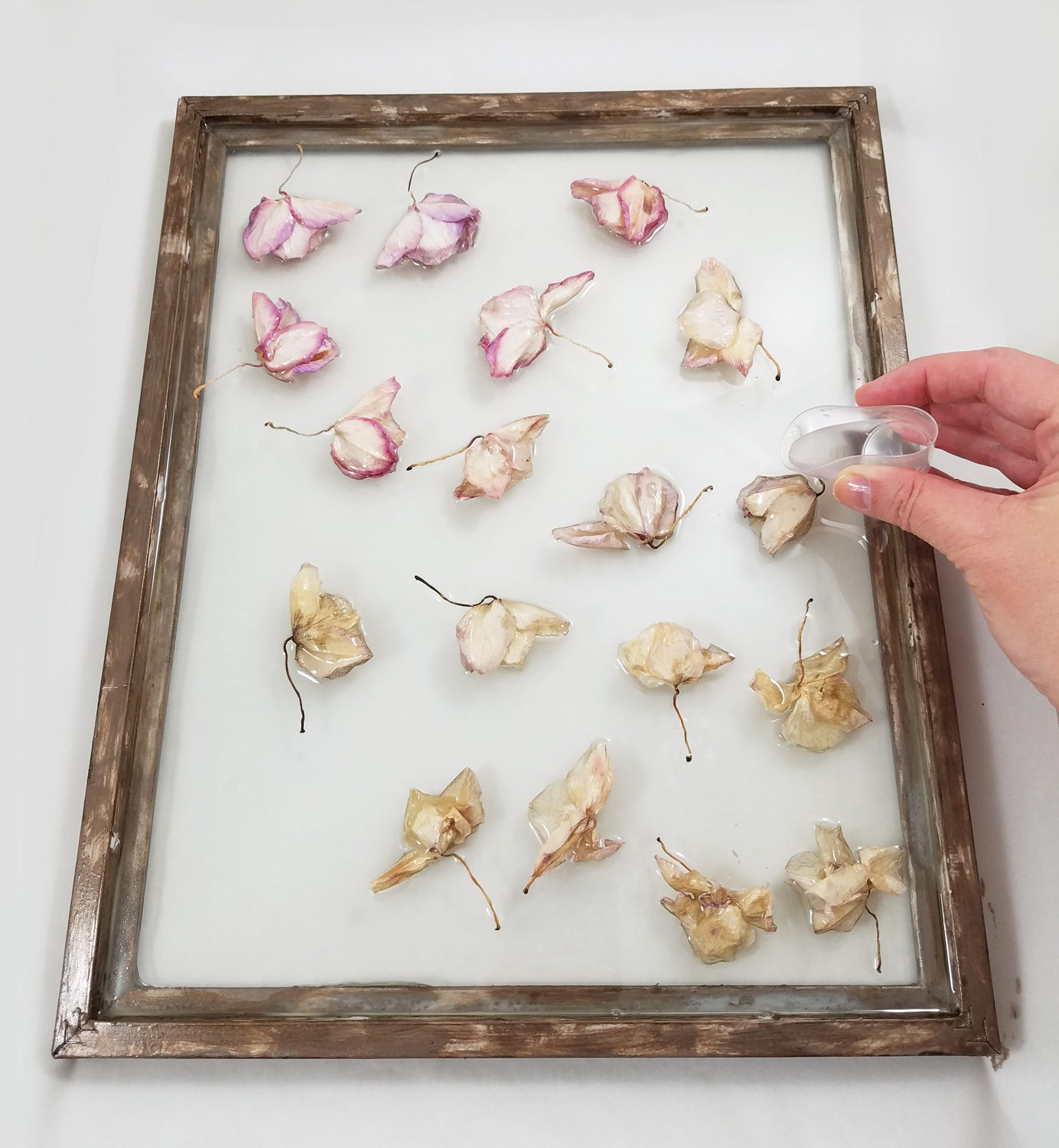
I added a second clear layer of Amazing Clear Cast Resin, to cover and protect the orchids. To make sure the resin completely encapsulated the orchids I would push some of the uncured resin around with a stir stick, moving the resin in and around the blooms. I let this layer of resin cure completely.
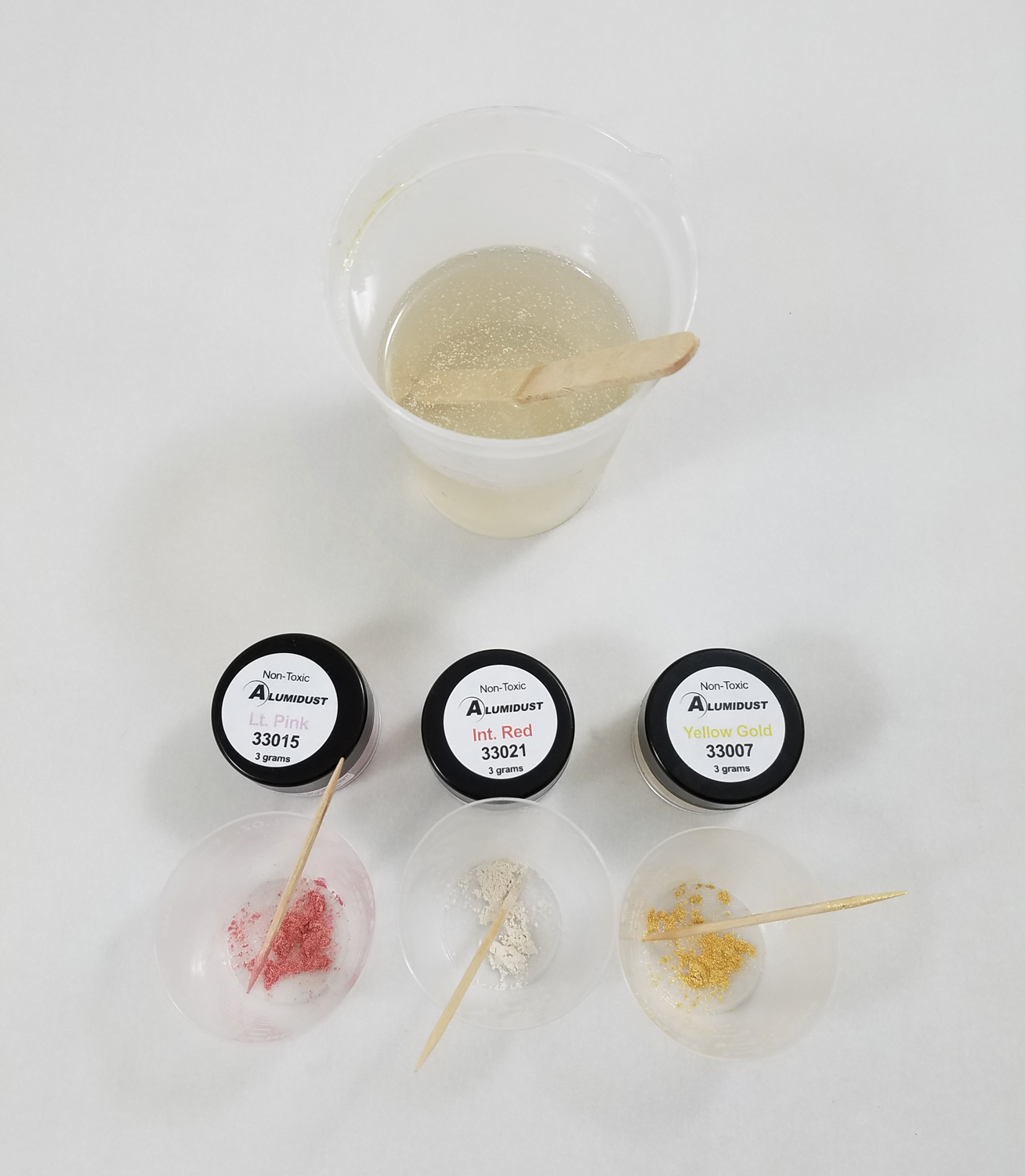
Mixing up a new batch of Amazing Clear Cast Resin, I put a pinch of Light Pink, Interference Red and Yellow Gold Alumidust in separate small measuring cups. I then carefully added the liquid resin into each cup carefully stirring with toothpicks to fully mix in the powders.
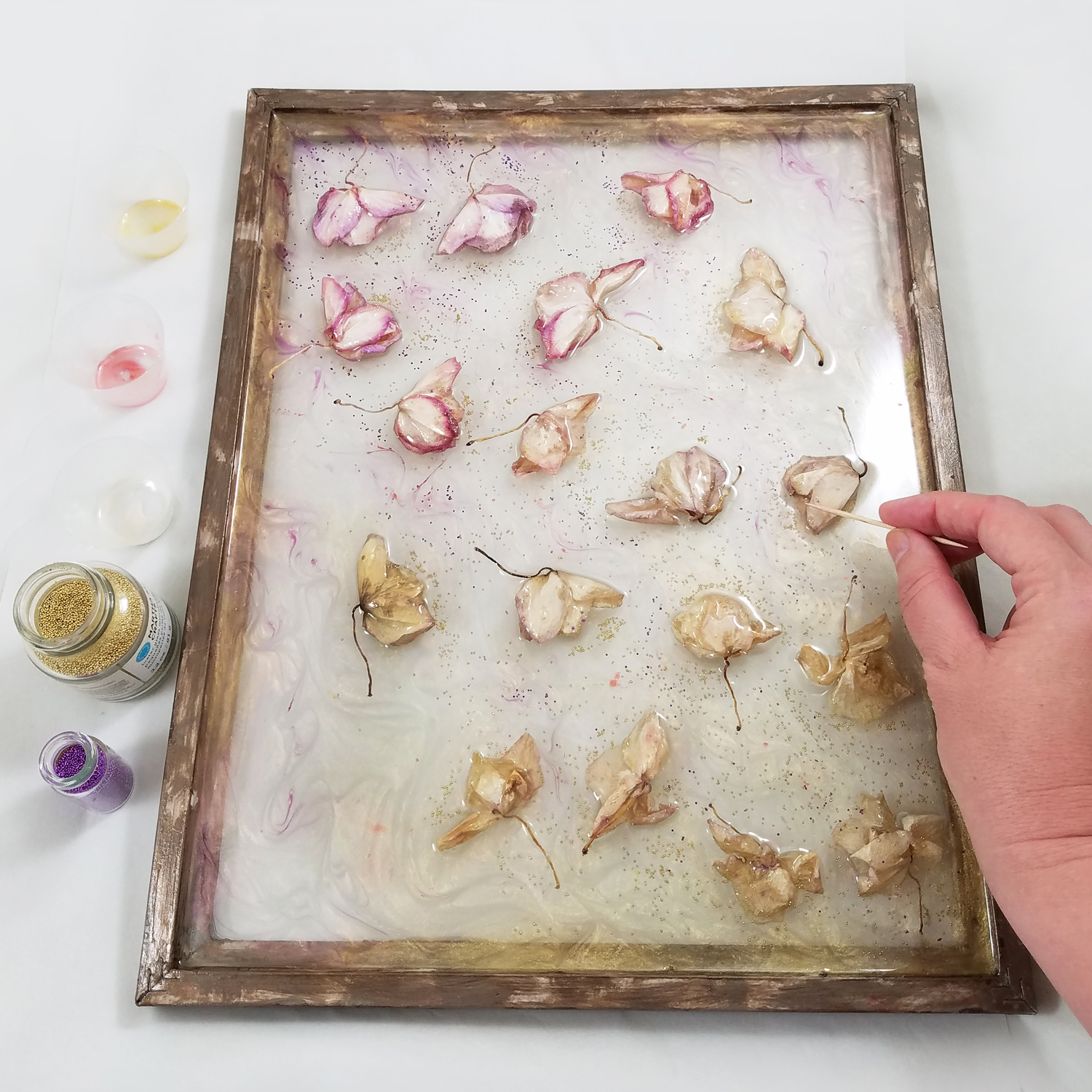
I poured the resin mixed with Alumidust in different spots all over the frame and used a toothpick to drag the colors through each other. This created a lovely ebb and flow of color to the resin, and I honestly lost track of time doing this and found it rather relaxing and meditative in nature. I sprinkled in some Micro Hole-less Glass Beads in Gold and Purple around the blooms in this layer of tinted resin before the resin cured.
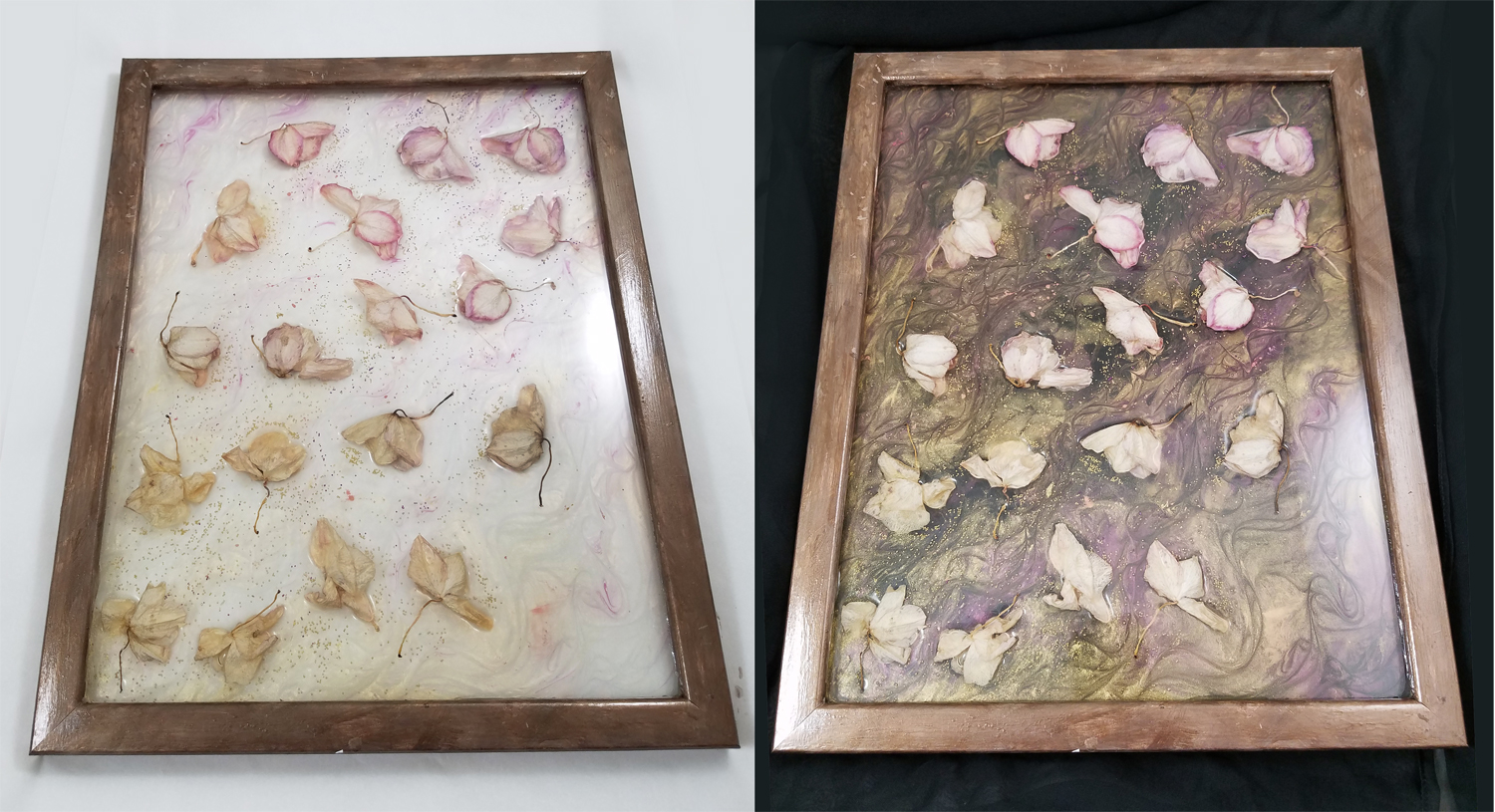
I had planned on doing a final cream color tinted layer for the background, but the lovely powder layer got lost when I tried a test sheet of white paper behind it. I needed more of a color contrast, so I thought about a black tinted layer or resin, using a black cloth to mimic the look, allowing the Alumidust tinted resin layer to visually pop more.
*In the future if I want to use a cream or light colored background I just need to make sure I use more Alumidust or a few drops of Alumilite Dyes to increase the color intensity without the need of a contrasting background.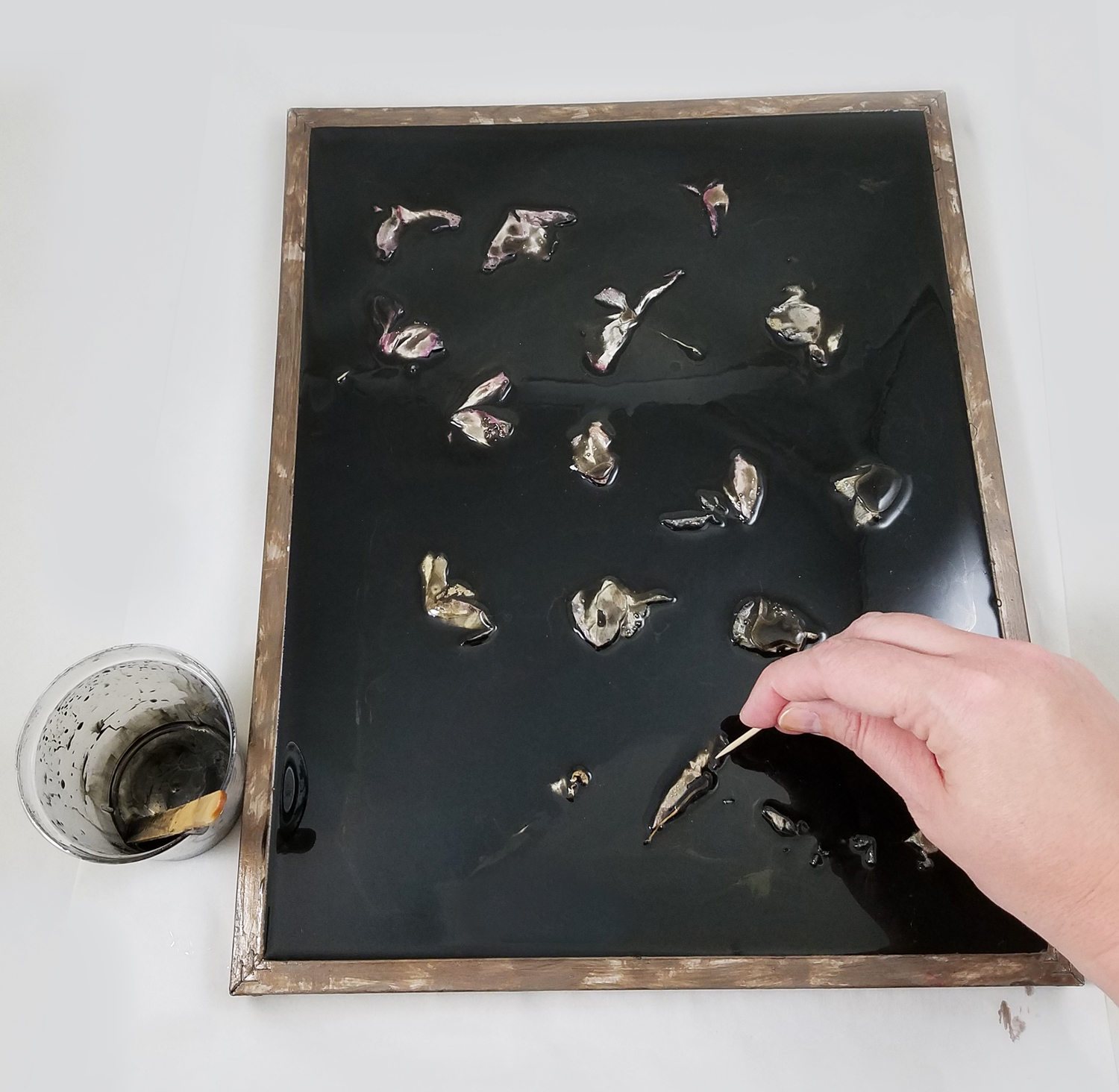
Mixing up a final batch of Amazing Clear Cast Resin I added Black Alumilite Dye Black to the resin, making sure to fully stir in all the dye. I poured the resin over the orchids and previous resin layer, carefully popping bubbles and making sure the tinted resin went into all the nooks and crannies.
*The dried orchids in this photo are slightly raised as they were not dried flat but collected already dried from a live plant. If the look of filter light going through the resin coated flowers is not the desired appearance just used pressed flowers instead.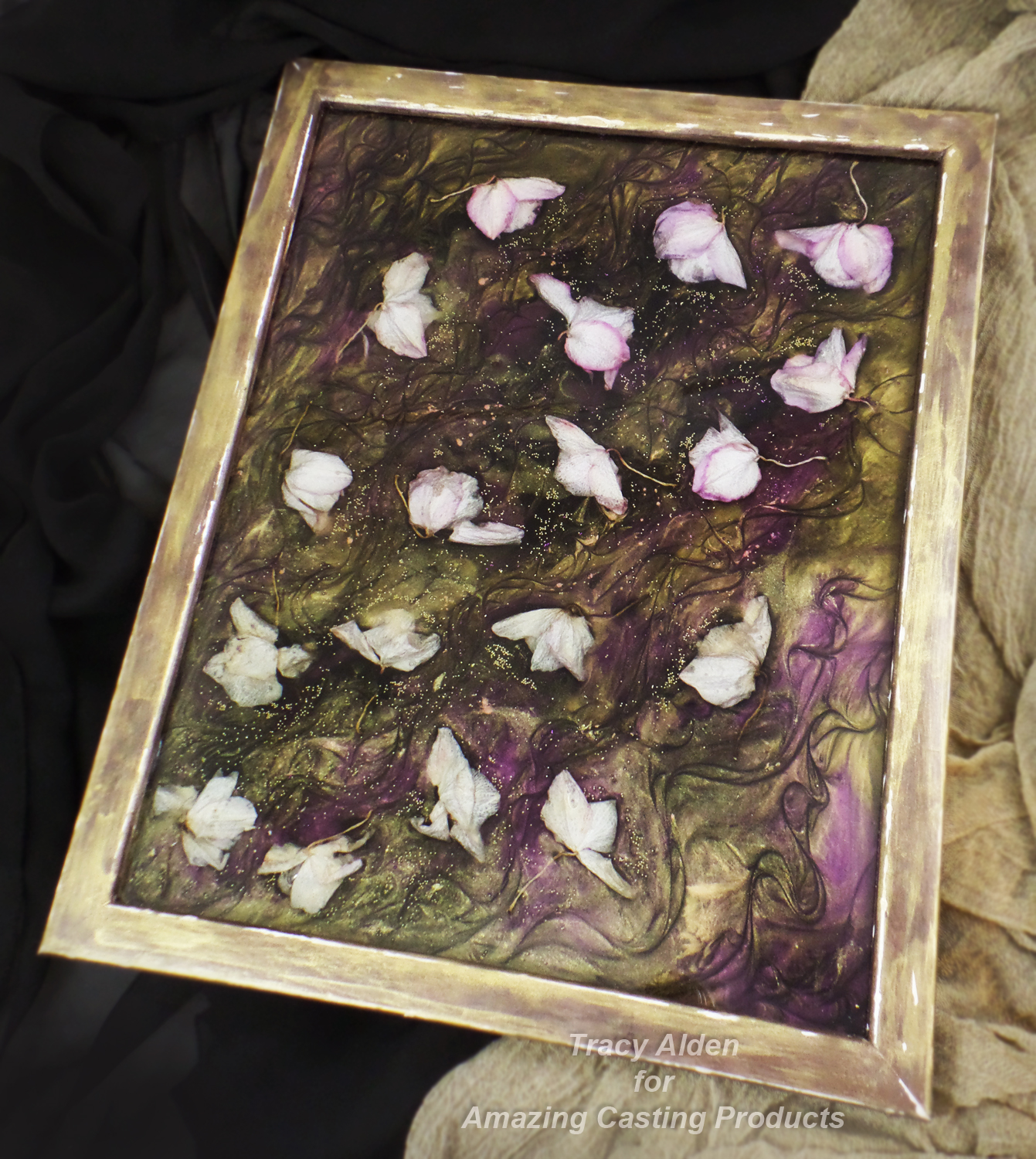
Here it is with the final layer of black tinted resin. The Alumidust not only creates a wonderful metallic shimmer but changes color and tone depending on how the frame is tilted or what type of light source is used!
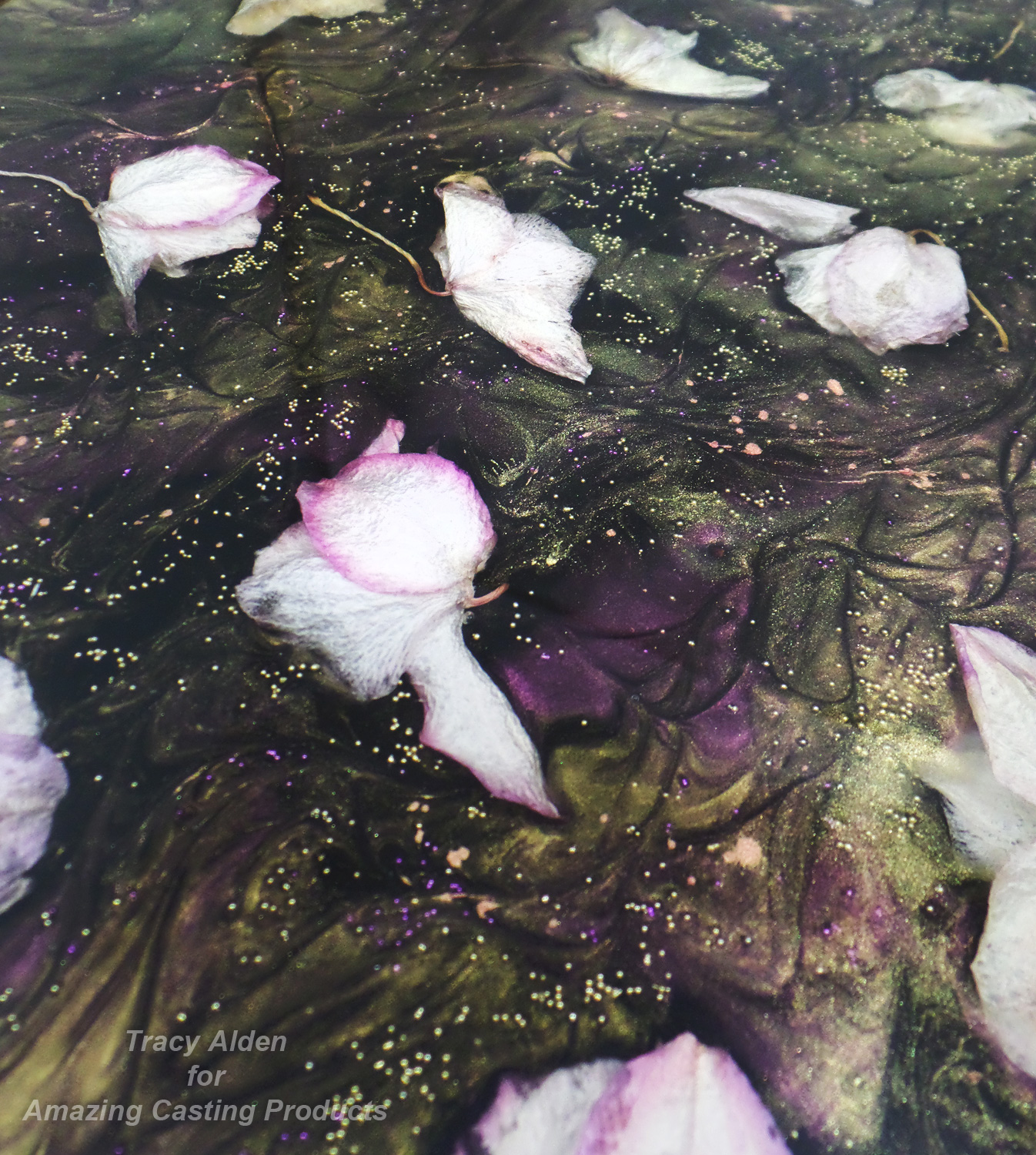
This test of both dried materials and the ability to quickly change the direction of the project worked out well. The frame looks complicated but it is just four layers of resin poured. No waste of resin just a few popsicle sticks, toothpicks and clean up with baby wipes.
With a simple change of dyes, powders and their concentration any number of lovely art can be created with few supplies!Until Next Time, Safe Travels!A #Cre8time trip to Ancient Greece with Amazing Casting Products and Stencil Girl Products
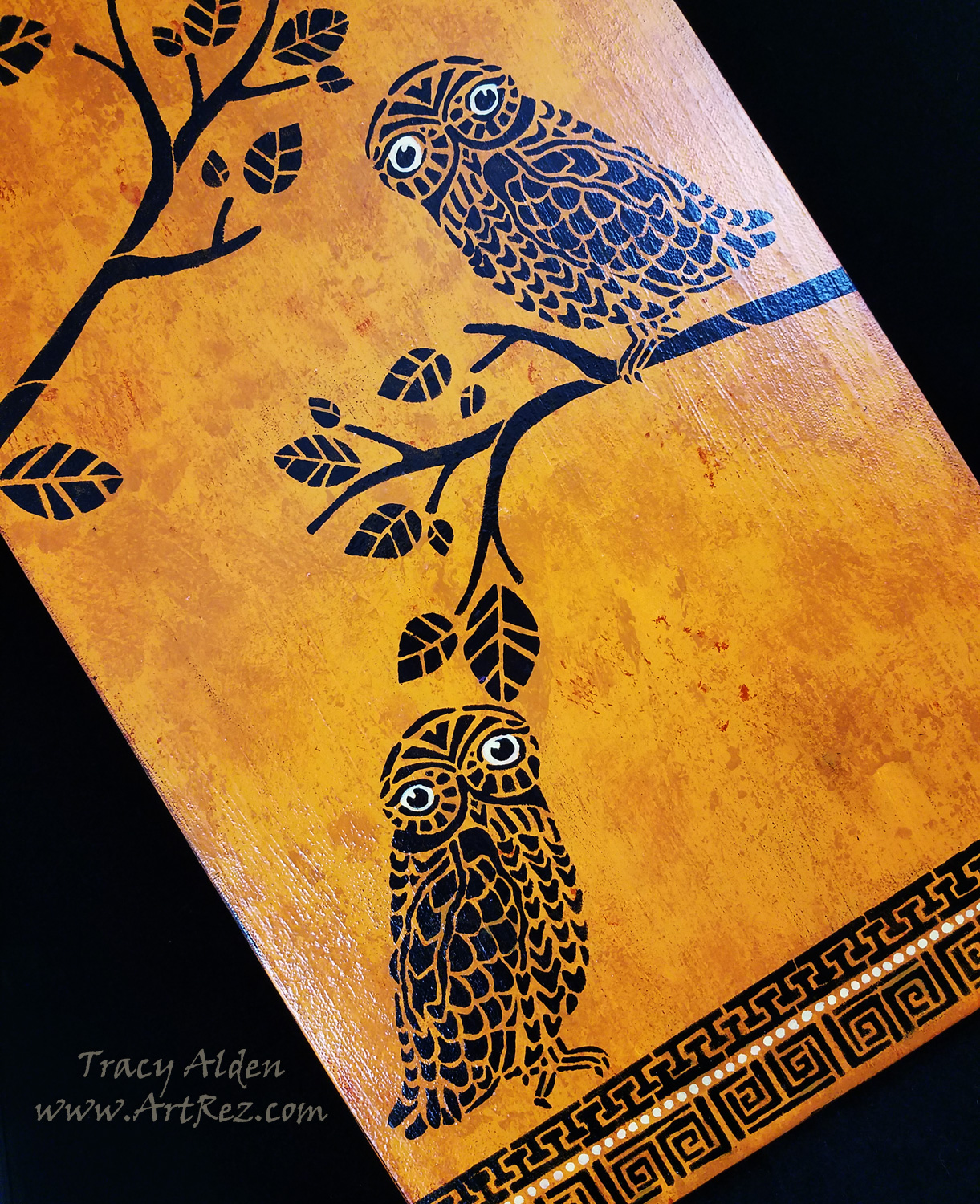
Hello! Tracy here with something special this month, a wonderful collaboration between Amazing Casting Products and Stencil Girl Products! Showcasing projects by incorporating Stencil Girl stencils along with Amazing Mold Putty and Amazing Clear Cast.
When I was given the chance to look through the Stencil Girl Products online catalog of stencils, there was so many to choose from! After seeing their Three Owls and a Branch stencil I immediately got an idea for a canvas piece. One of the owls in particular reminded me of Athena’s owl from the original Clash of the Titans movie, and once I saw the Stitch a Greek Border stencil I just knew I had to do a Grecian inspired piece!
Supplies:
Amazing Mold Putty
Amazing Clear Cast Resin
Stencil Girl Products Three Owls and a Branch 9″ X 12″ stencil
Stencil Girl Products Stitch a Greek Border 9″ X 12″ stencil
12″ X 24″ Canvas
Painter’s Tape
Paint Brush
Cosmetic Sponges
Acrylic Paint (Black, Yellow, Pale Yellow, Brown and Orange)
I mixed together the Yellow, Brown and Orange acrylic paints and applied it to the surface of the canvas. I did about two coats of paint to get a mostly even color tone.
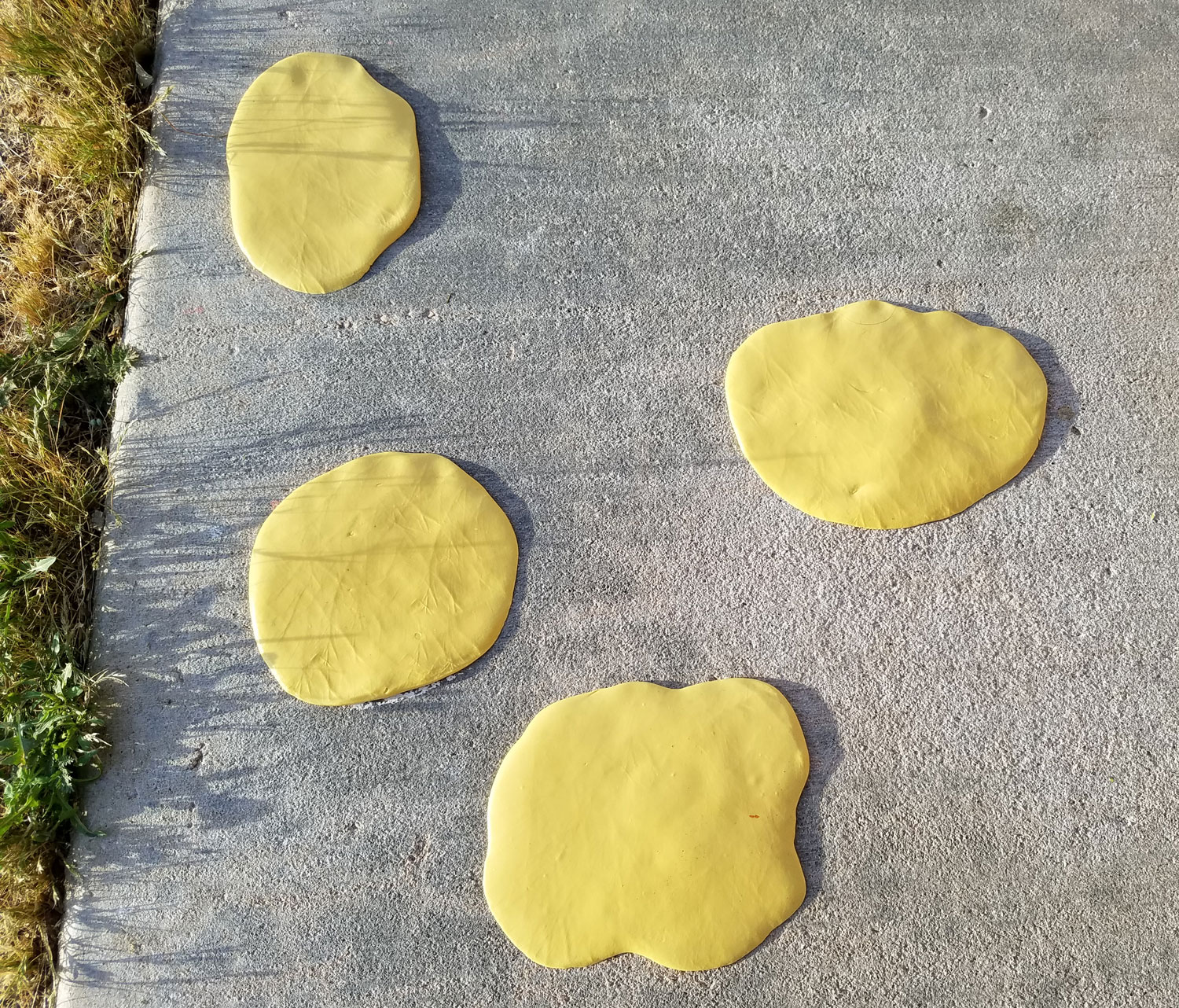
While the paint on the canvas was drying I scrubbed and cleaned a rough patch of sidewalk in my front yard. Once the cement was dry I mixed up some Amazing Mold Putty{CLICK HERE to view mixing/preparation}, and pressed the putty into the most textured spots of the sidewalk. I let the mold putty cure and carefully peeled the putty off the sidewalk.
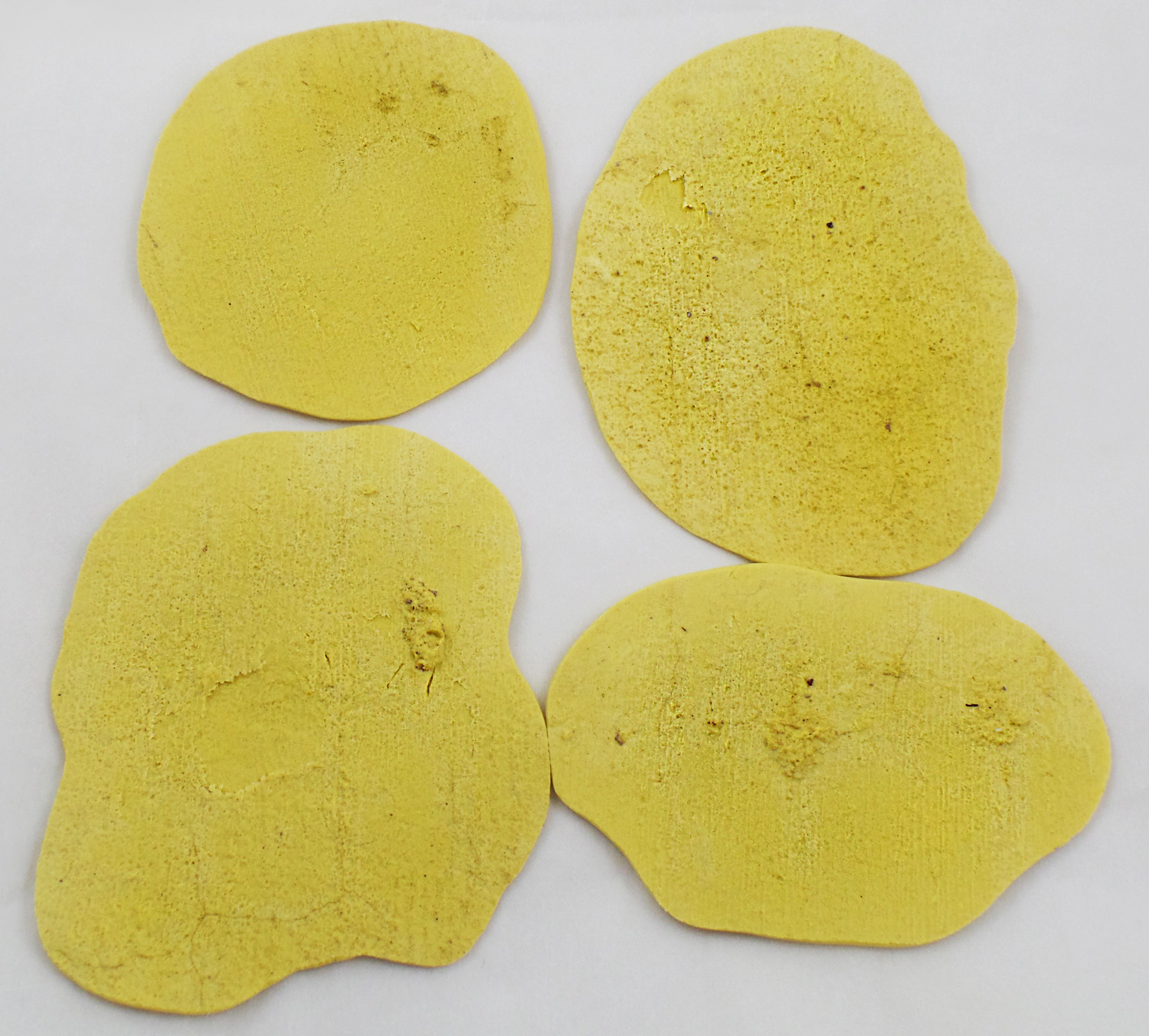
Once removed from the sidewalk I now had wonderful one of kind texture plates to use as stamps!
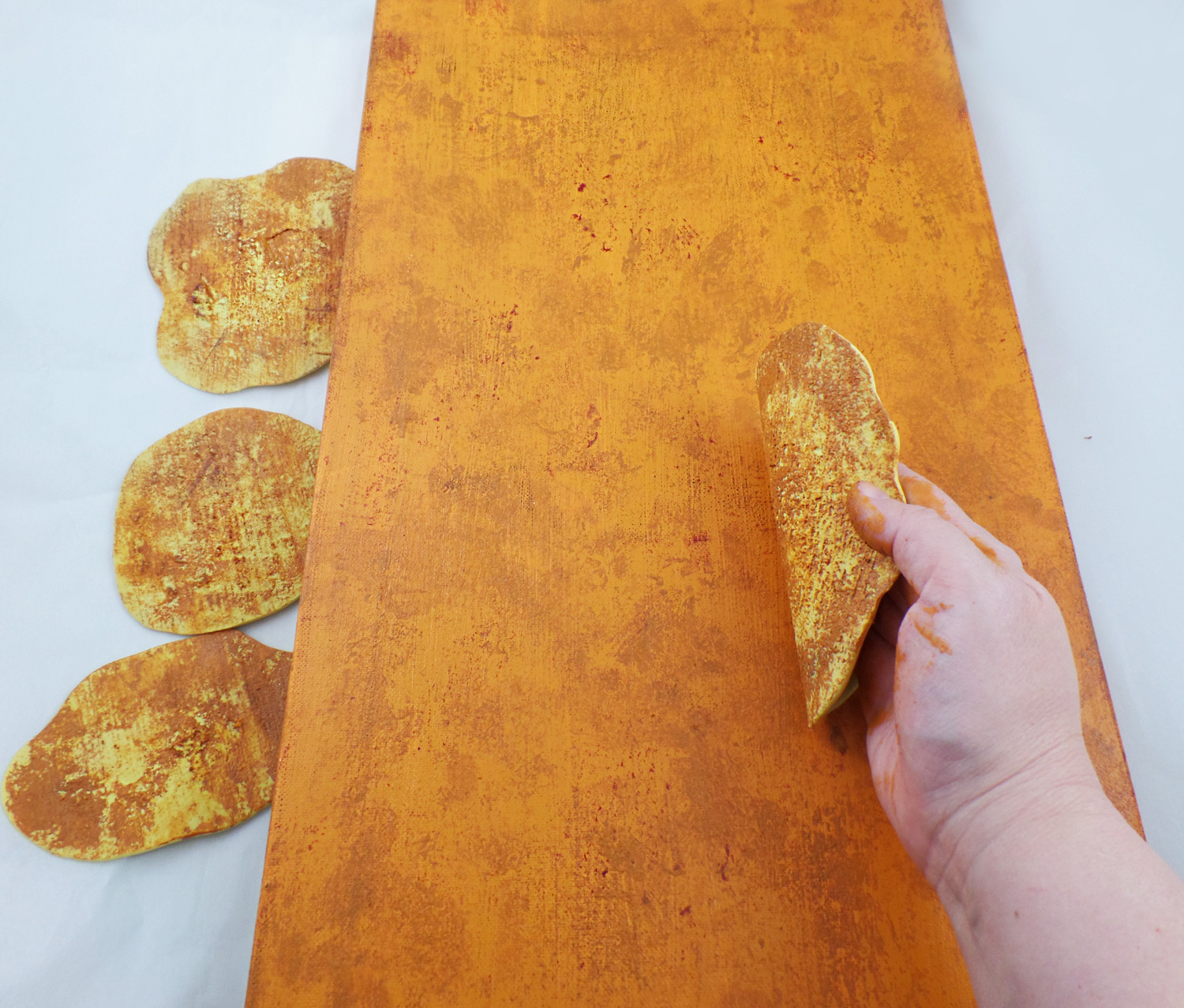
To each Amazing Mold Putty stamp I applied a light coat of acrylic pant and stamped it all over the surface of the canvas. There was no rhyme or reason to the placement, just anywhere I wanted to create a controlled splatter of color. By using several colors of paint the surface started to mimic aged Grecian frescoes and pottery. I let the paint dry fully.
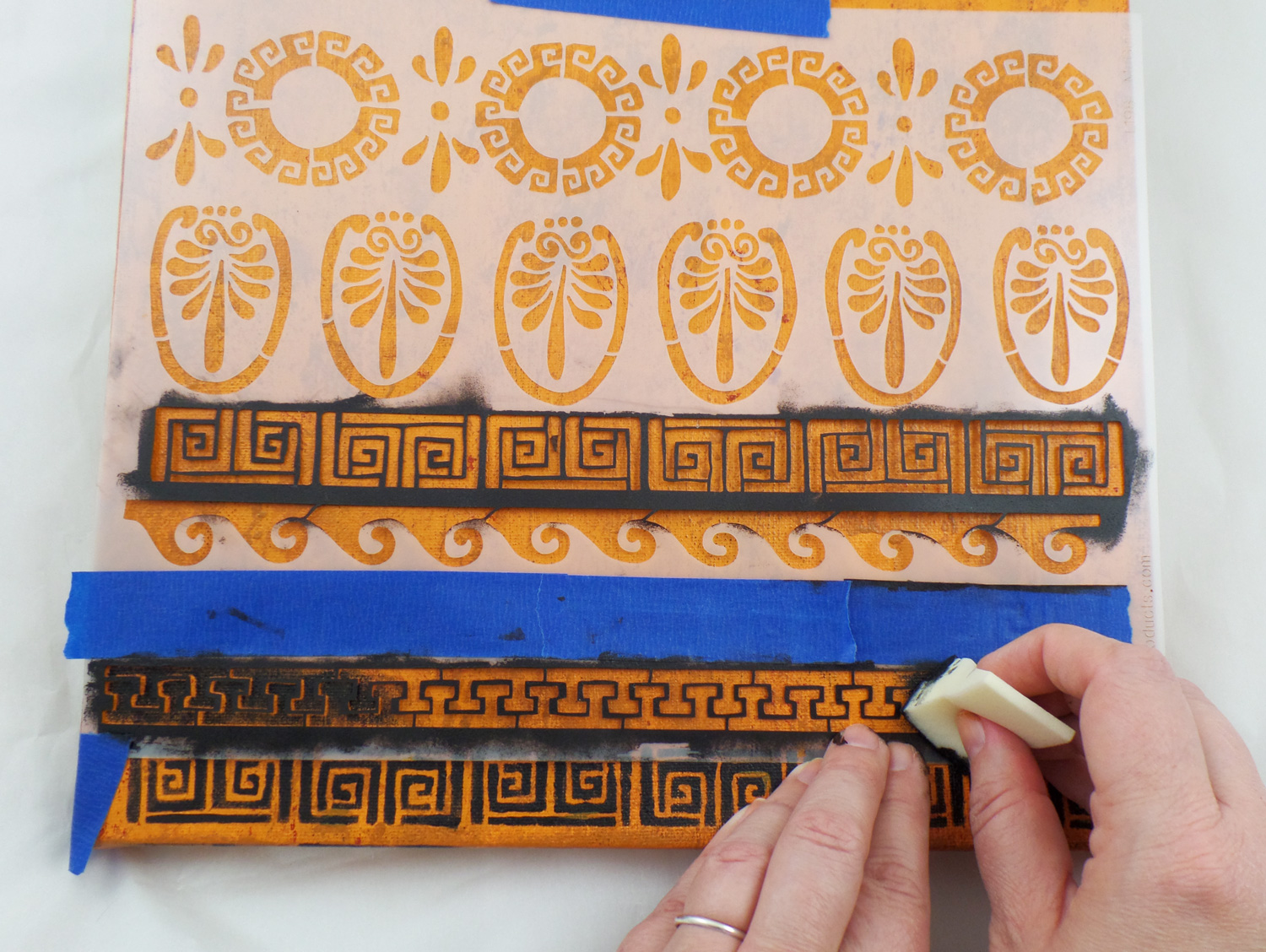
Using painters tape I taped in place the Stencil Girl Products Stitch a Greek Border on the bottom of the canvas and picked two different trim patterns to stencil. By using painter’s tape, it will hold the stencil in place but not damage the painted surface (nor the stencil), allowing for easy repositioning. I then poured a small amount of Black acrylic paint on a palette and dabbed a cosmetic sponge lightly into the paint. I carefully applied the paint while holding the stencil in place to prevent any slight slippage of the stencil. If an area needed a second coat of paint it was easy to go back and reapply paint without any worries of paint overloading. I repeated this for the top of the canvas as well.

The Stencil Girl Products Three Owls and a Branch stencil allowed for a lot of artistic freedom by simply blocking off sections I did not want paint to go through with painter’s tape. By flipping over the stencil or moving it around at different angles I was able to create many tree branches with ease.
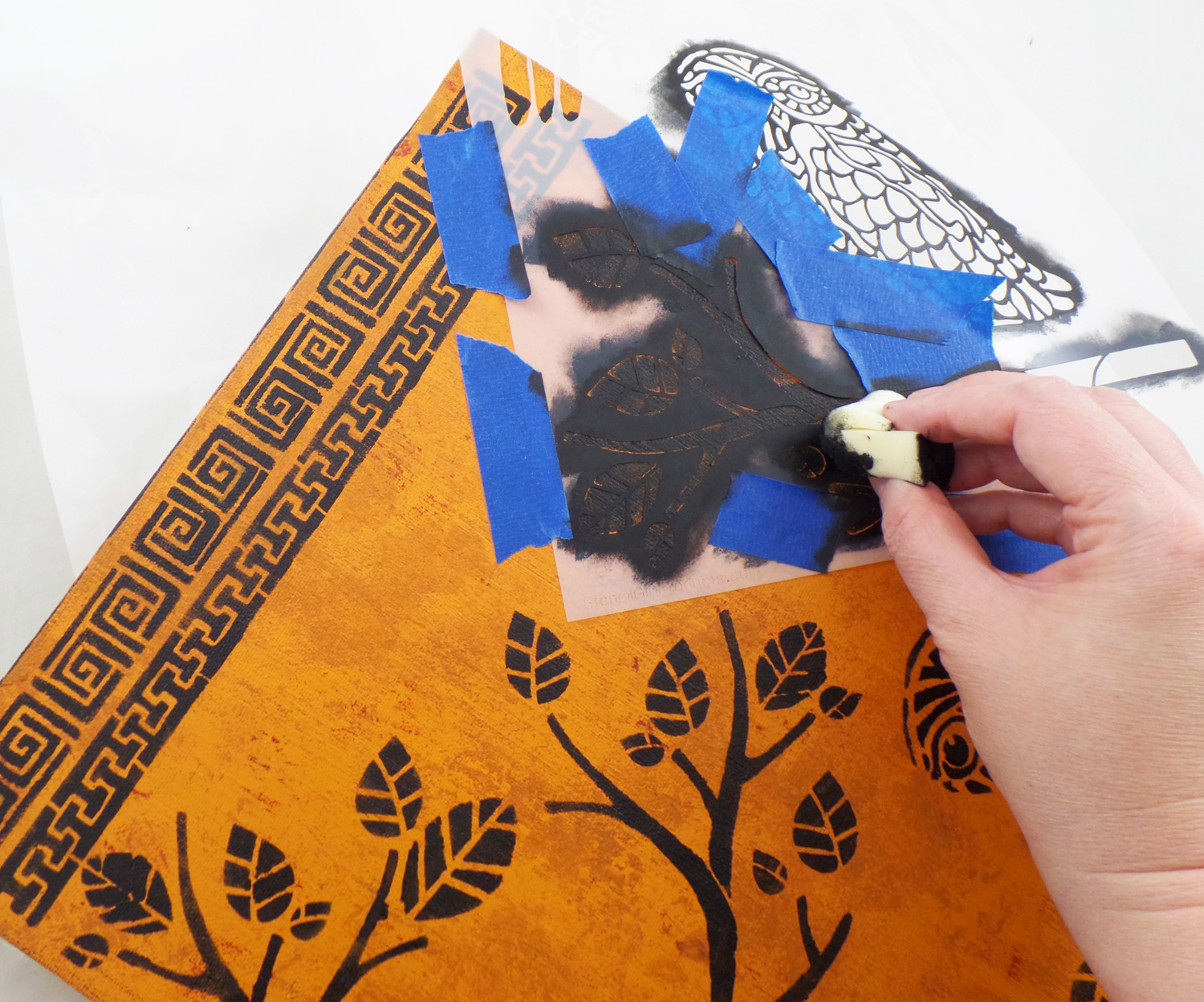
With a few branches I even taped off some of the leaves to create the look of tree just starting to sprout leaves in Spring. Once I was done stenciling it was easy to clean the stencils by placing them in a small tub with soap water and gently rubbing the paint off.
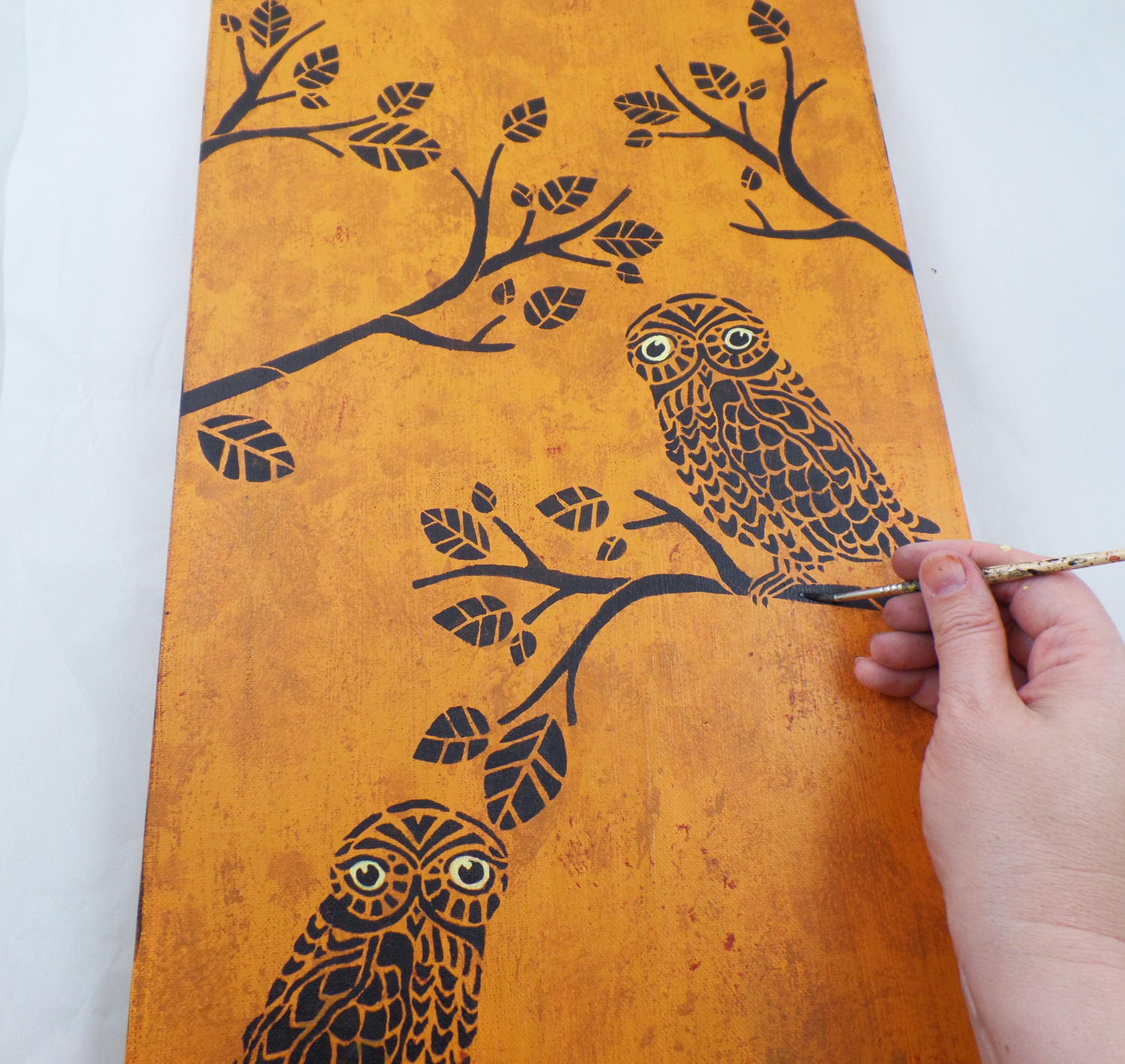
Once all of the paint was dry I went back to fix any stenciling mistakes I had made with a small paint brush. I then added some Light Yellow acrylic paint to the eyes of the owls and trim to further replicate the look of ancient Greek art.

I mixed up some Amazing Clear Cast Resin, let it sit for 10 minutes, and applied a thin layer to the front of the canvas with a cosmetic sponge. I applied the resin slowly, a downward motion, top to bottom of the canvas. I didn’t mind if I had little bumps and canvas texture showing through, as the resin was acting as a color intensifier and a thin protective coating. I let the resin fully cure for 24 hours before handling.
*If I wanted a more of a glassy smooth surface I would apply a second or even third layer of resin without a cosmetic sponge.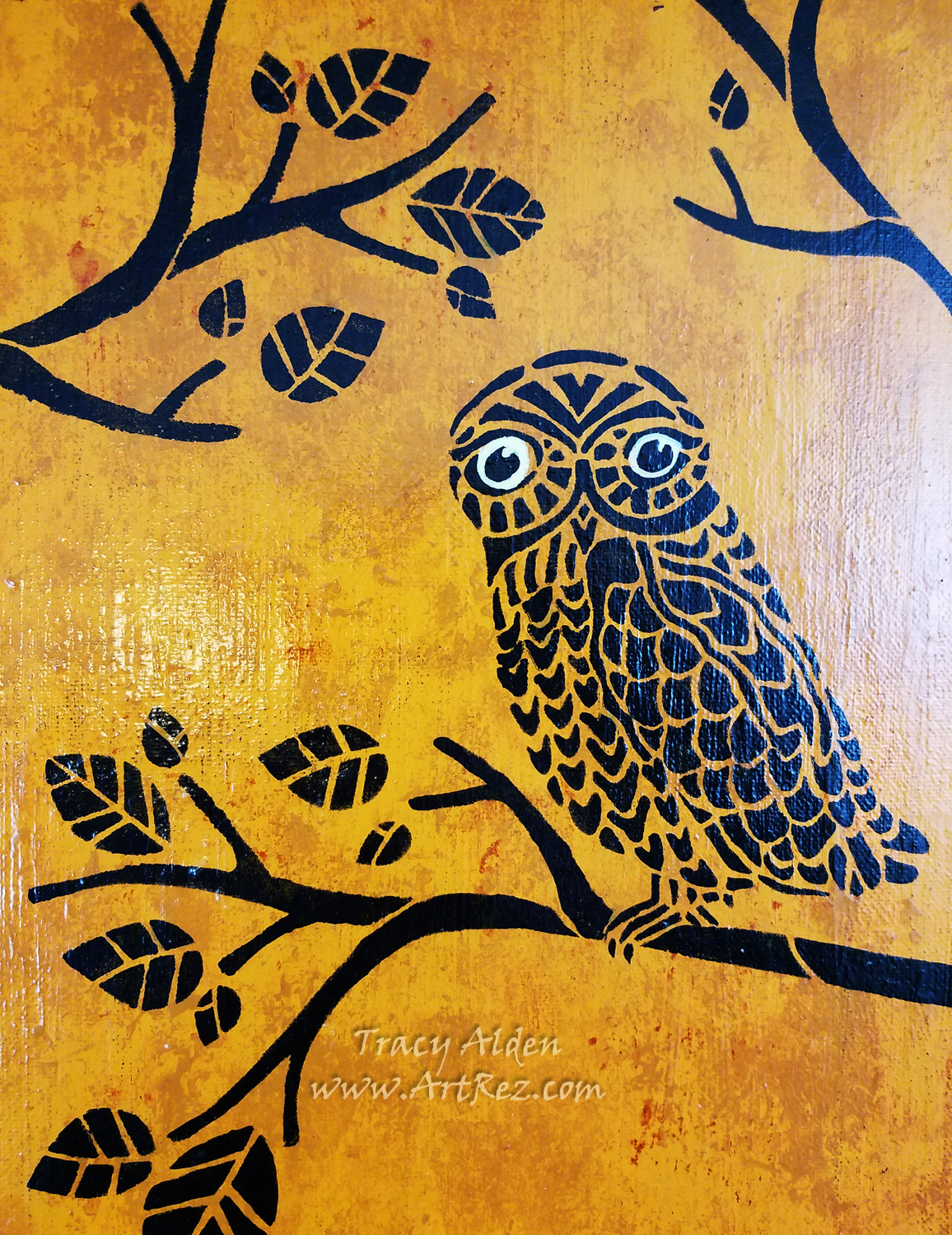

Now completed, Athena’s ever watchful owls seem to be right off an ancient fresco!
Until Next Time, Safe Travels!

